

What Is The Bitcoin Travel Rule?
Home » Articles » What Is The Bitcoin Travel Rule?
- Published on November 15, 2023
Share this article
Bitcoin, as it states in the white paper, is peer-to-peer electronic cash; it has no central issuer since anyone who can mine can earn it, while those who wish to acquire it can do so by trading something of value with another person. These trades can be conducted as fiat to Bitcoin trades, trading your time and labour for Bitcoin or selling goods for Bitcoin.
Peer-to-peer markets for Bitcoin exist, as do a few Bitcoin circular economies where trades like those mentioned above are becoming the norm, but these users or Bitcoiners are exceptions, not the rule.
The overwhelming majority of people who wish to acquire Bitcoin do so by heading towards a regulated entity such as an exchange or fintech company and conducting their trades within these regulated walled gardens.
While exchanges and fintech apps make it nearly frictionless and easy to exchange your fiat for Bitcoin or vice versa, they are not without their trade-offs. To access these walled gardens, you need to provide proof of your identity, abide by a host of KYC and AML rules, and run the risk of associating all your purchases with your identification.
Exchanges becoming a choke point instead of a gateway
Exchanges work well until they don’t, and we’ve seen examples of exchanges going bust, closing down people’s accounts, blacklisting users and having private user data leaked, putting their customers at risk.
These are very real concerns when you deal with a 3rd party custodian and should not be taken lightly; they are a central point of failure and pressure and make it easy for regulators and governments to put a chokehold on a local Bitcoin market.
If the vast majority of a particular country’s Bitcoin trading happens on a local platform, shutting down or limiting that entity’s ability to offer Bitcoin trades can be devastating. It also enables the ability to easily 6102 individuals Bitcoin if users leave their funds with a service provider.
While this might sound like hyperbole to you now since we haven’t had an example of mass confiscation of funds or widespread blacklisting of users, the building blocks for it are surely starting to take shape with the update of the travel rule now starting to apply to Bitcoin transactions.
What is the Bitcoin Travel Rule?
The Bitcoin travel rule, officially known as the FATF (Financial Action Task Force) Recommendation 16, is a regulatory requirement claiming its aim is to combat money laundering and terrorist financing by enhancing transparency in cryptocurrency transactions.
This rule, adopted by the FATF in 2019, mandates that virtual asset service providers (VASPs), such as cryptocurrency exchanges and wallet providers, exchange certain customer information with each other when transferring virtual assets above a specified threshold.
Key components of the Travel Rule
The Bitcoin travel rule encompasses several crucial elements that contribute to its effectiveness:
- Customer Identification: VASPs are mandated to collect and verify customer information, including names, addresses, and identification numbers, for both the sender and recipient of cryptocurrency transactions.
- Transaction Threshold: The rule applies to transactions exceeding a specified threshold, which varies depending on the jurisdiction. In some regions, the threshold is set at $1,000, while others may have higher or lower limits.
- Information Sharing: VASPs must exchange customer information with each other when sending or receiving cryptocurrency transactions above the threshold. This information exchange enables authorities to track the movement of funds and identify potential red flags.
- Sanction Screening: VASPs are required to check counterparties against sanctions lists to prevent transactions with individuals or entities under sanctions.
- Due Diligence: VASPs must conduct due diligence on counterparties to assess their risk profiles and ensure compliance with the travel rule.
The original (fiat) Travel Rule
Published in January 1996, the Financial Crimes Enforcement Network (FinCEN) Advisory presented the original Travel Rule:
A Bank Secrecy Act (BSA) rule [31 CFR 103.33(g)]—often called the “Travel” rule—requires all financial institutions to pass on certain information to the next financial institution in certain funds transmittals involving more than one financial institution. ( FinCEN 1997 )
The rules remained unchanged for several years and never applied to Bitcoin for the first decade of its existence. Only i n 2019 did the Financial Action Task Force (FATF) update its recommendations to extend them, including the Travel Rule, to virtual assets (VAs) and VA service providers (VASPs).
Since the expansion of the travel rule in 2019, several countries — including Germany , Singapore , Switzerland , Canada , the United States , South Africa , the Netherlands , Estonia and a few more — have adopted or introduced legislation that mirrors these FATF-driven AML compliance obligations.
Even if the travel rule doesn’t apply to you now, consider it a work in progress and plan accordingly. Like anything regulatory, the larger economies set the rules, and the rest eventually follow.
The essence of the travel rule
The core principle of the Bitcoin travel rule lies in its ability to trace the origins and recipients of cryptocurrency transactions, thereby enabling authorities to identify and investigate potentially illicit activities.
By requiring VASPs to collect and share customer information, the rule seeks to bridge the anonymity gap inherent in Bitcoin transactions, making it more difficult for individuals to access the wider Bitcoin network via exchange on-ramps.
The claim is that by adding more onerous requirements to send and receive Bitcoin when using an exchange, there is less chance of criminals using exchanges to liquidate the proceeds of crime. The truth is criminals can always find ways around this, such as selling on P2P markets, purchasing KYC accounts that are for sale through online markets, and using complex mixing services and stablecoins to conduct business.
The only ones affected by the travel rule are law-abiding citizens who will need to provide even more information every time they withdraw funds to an on-chain wallet or those sending on-chain Bitcoin to exchange to liquidate it to acquire cash.
The travel rule will not only increase your KYC footprint but also make it harder for you to hide your on-chain footprint, which can put you at risk should that data ever be leaked.
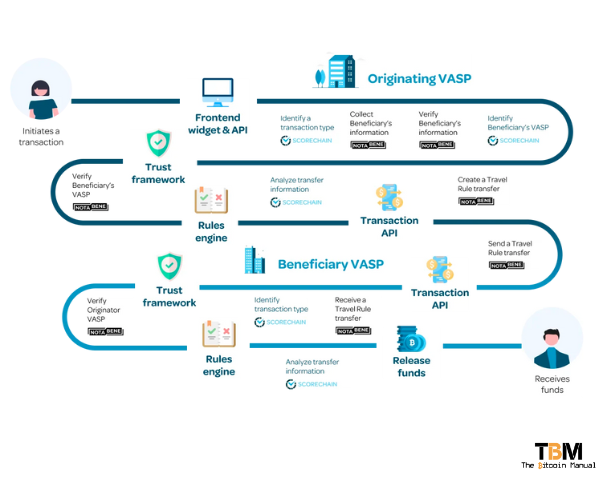
Impact of the Bitcoin Travel Rule
Implementing the Bitcoin travel rule will significantly impact the Bitcoin industry, introducing a new layer of compliance and accountability and making it more expensive to offer compliant Bitcoin services. While some industry participants have expressed concerns about the rule’s potential to hinder innovation and reduce privacy, others view it as a necessary step towards legitimising Bitcoin and fostering a more responsible financial ecosystem.
Those who welcome it also see the added regulation as another barrier to entry, reducing the possibility of future competition entertaining the space and securing their place in the current regulated Bitcoin market.
Under the crypto Travel Rule, VASPs and Bitcoin businesses must share customer information when transferring Bitcoin, or digital assets, above the threshold.
This personally identifiable information (PII) must include: (Note this may vary based on your country)
Sender reporting requirements:
Recipient reporting requirements:
What are the concerns around the travel rule?
Applying the travel rule to Bitcoin is not without its controversies and brings a lot of concerns to the Bitcoin community.
- The Travel Rule can be considered a breach of individuals’ privacy rights.
- There’s a common belief that the regulations will slow down blockchain development in the EU and halt innovation in the industry.
- The negative impact comes from the requirement to collect data on the transactions, which could make crypto exchange activities slower and more expensive.
- Technical experts are concerned about the security of the data. More specifically, combining the data with information from the Crisis Management Platforms and the European Commission, European Central Bank, and European Banking Authority could make it vulnerable to cyber-attacks.
- There is an additional risk from illicit or fake VASPs who might use legislation as an opportunity to collect user data, as well as from oppressive regimes seeking to control legitimate users of Bitcoin as a method of moving funds outside the system.
- Travel Rule requires VASPs to share the personal information of a transaction’s sender and recipient with other financial businesses or VASPs. Since the FATF does not advise the use of any specific data-sharing technology, there is no single protocol or network for data transfer. That is why several third-party networks for encrypted data transfers exist, including OpenVASP, Shyft, and Trisa, which only add to the complexity, the data footprint and the chances of data leaks.
The travel rule could be part of a spot ETF push.
If the travel rule makes it harder for exchange users to move funds in and out of platforms and makes it more expensive for exchanges to operate, why would exchanges want to comply with this added regulation?
The obvious reason would be they do not want to be shut out of large markets like the U.S. and are willing to play ball to access the customer base, but it could also be a play for a future approval of a spot ETF. If one is approved, regulated custodians will be required to custody the Bitcoin on behalf of these ETFs, and these exchanges will need to comply with strict regulations on the type of coins they hold and how they move funds in and out of their service if they want to capture some of that spot ETF inflows.
To help make exchanges more attractive, we’ve already seen some of them push for the creation of interoperable systems for compliance. Paxos, with partner members including Coinbase, Circle, Gemini and Kraken, introduced Travel Rule Universal Solution Technology.
This initiative aims to aid exchange compliance in the U.S. and beyond, with exchanges obliged to meet security and privacy requirements and create platforms that are preferred custodians for ETF-managed funds.
Keeping your Sats safe requires secrecy.
Travel Rule enforcement is simultaneously a significant milestone and the biggest setback for Bitcoin, depending on how you see the asset. If you’re only in it for the capital appreciation in fiat terms, you would have no issue with these rules since you never planned on spending or using the funds outside an exchange, and the only reason you hold Bitcoin is to sell it for fiat later.
If you only use Bitcoin as a trade, and the funds remain in a walled garden and trust a third-party custodian, these rules won’t affect you. You may welcome the rules since they make it harder for capital to flow in and out of exchanges and could drive up volatility in these markets.
Additionally, the building of regulated walled gardens for Bitcoin could be the base needed for the approval for a spot ETF, which will bring institutional money into the market and pump ye o’l bags.
On the flip side, the Bitcoin travel rule represents another step backwards in improving financial privacy in the Bitcoin realm. Adding more personal information relayed on transactions facilitates traceability, putting users at risk. That data could fall into the hands of hackers who could target these users with online or in-person attacks or used by governments who wish to place oppressive measures on capital , leaving their failing economies.
If you believe in self-covering money and financial privacy, you first should accept that exchanges will not be friendly towards your ideals and use of Bitcoin. You may need to cut ties with exchanges, sell off your KYC Bitcoin and re-buy on P2P markets. P2P market premiums might not be so expensive in the future when compared to centralised exchanges, which might need to increase their fees to pay for the additional operational costs, making P2P purchases more attractive .
If you do remain with a KYC exchange, you will need to consider consolidating your coins in an on-chain wallet and mix it with the mixing service of your choice later so your coins cannot be traced back to you and your future spending habits are no longer monitored.
While you can never get rid of the initial purchase data from the exchange, those who have that data will not be able to follow your funds after they’ve left the exchange.

Disclaimer: This article should not be taken as, and is not intended to provide any investment advice. It is for educational and entertainment purposes only. As of the time posting, the writers may or may not have holdings in some of the coins or tokens they cover. Please conduct your own thorough research before investing in any cryptocurrency, as all investments contain risk. All opinions expressed in these articles are my own and are in no way a reflection of the opinions of The Bitcoin Manual
Leave a Reply Cancel reply
You must be logged in to post a comment.
Don't subscribe All new comments Replies to my comments Notify me of followup comments via e-mail. You can also subscribe without commenting.
- Bitcoin Legislation , regulation
Related articles
You may also be interested in.
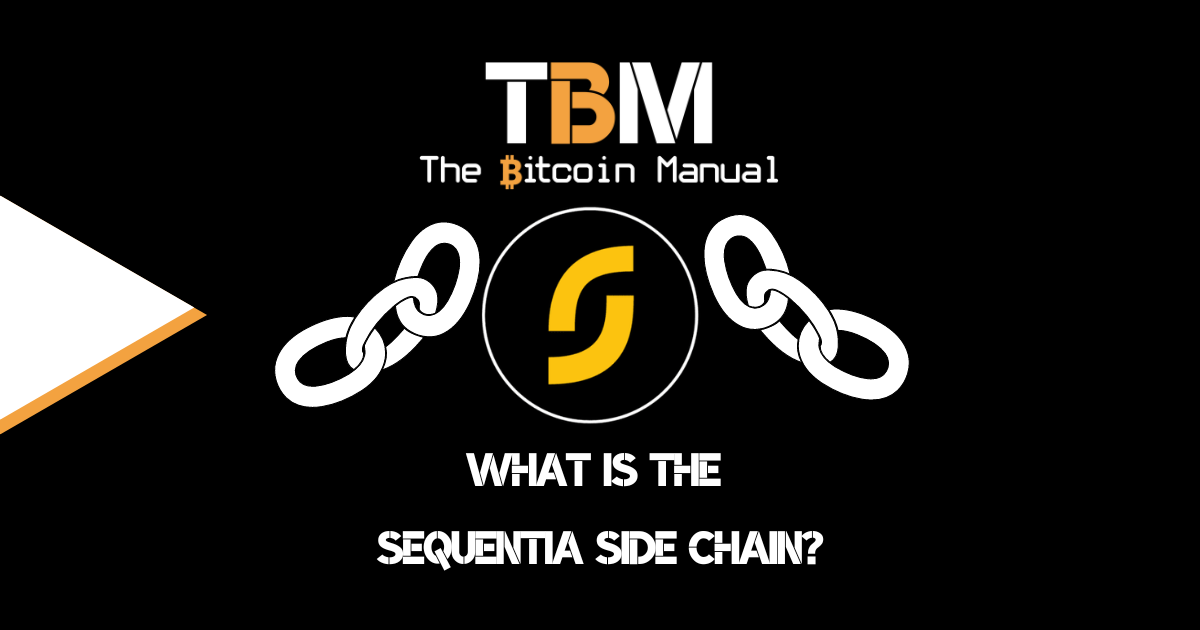
What Is The Sequentia Side Chain?
Bitcoin is optimised for security and reliability. Its design, while robust, has inherent limitations when it comes to scalability. The blockchain, the underlying technology, can
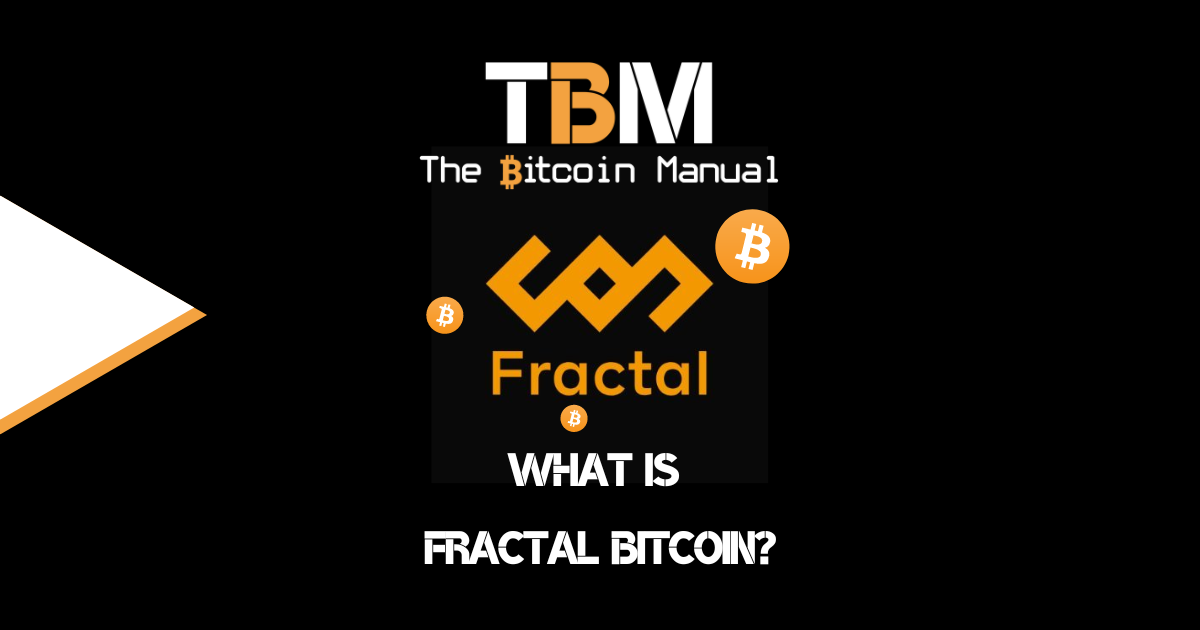
What Is Fractal Bitcoin?
It feels like nearly a lifetime ago now that Ordinals were making headlines and stirring up all sorts of arguments about how to use block
Switch themes
Sign up to our newsletter.
- Privacy policy
- Terms and conditions
- +40-200-4286-09
- [email protected]
- 83 Barbara St, Newark, NJ 07105
Hot daily news right into your inbox.
The Circle Pressroom
Press release, circle is first global stablecoin issuer to comply with mica, eu’s landmark crypto law.
Circle’s French entity is launching USDC and EURC issuance in the EU in compliance with one of the world’s most comprehensive regulatory regimes for digital assets
PARIS – July 1, 2024 – Circle , a global financial technology firm and the issuer of USDC and EURC , has today announced that it has become the first global stablecoin issuer to achieve compliance with the European Union's landmark Markets in Crypto-Assets (MiCA) regulatory framework.
This achievement was enabled by the company’s attainment of an Electronic Money Institution (EMI) license (’agr ément en qualité d'établissement de monnaie électronique) from the Autorité de Contrôle Prudentiel et de Résolution (ACPR), the French banking regulatory authority. With this license, both USDC and EURC are now being issued in the EU in compliance with MiCA’s regulatory obligations for stablecoins or e-money tokens, which took effect yesterday, according to the law today and subject to potential clarifications on the interpretation of the law by the European Commission.
As part of attaining compliance with this comprehensive regulatory regime, Circle Mint is officially available for business customers in Europe. Equipped with local banking capabilities, Circle Mint France provides near-instant and cost-effective access to mint and redeem USDC and EURC throughout the European market.
“Since our founding, Circle has sought to build durable, compliant, and well-regulated infrastructure for stablecoins, and our adherence to MiCA, which represents one of the most comprehensive crypto regulatory regimes in the world, is a huge milestone in bringing digital currency into mainstream scale and acceptance,” said Jeremy Allaire, Co-Founder and Chief Executive Officer at Circle. “By working closely with French and EU regulators, we are now able to offer both USDC and EURC as fully-compliant dollar and euro stablecoins to the European market, unlocking the enormous potential of digital assets to transform finance and commerce.”
"Achieving MiCA compliance through our French EMI license is a significant step forward, not just for Circle, but for the entire digital financial ecosystem in Europe and beyond," said Dante Disparte, Chief Strategy Officer and Head of Global Policy at Circle. "As digital assets become increasingly integrated into the mainstream financial landscape, it is essential that we establish robust, transparent frameworks to promote trust and adoption. Today’s announcement further reinforces our commitment to building a more inclusive, compliant future for internet finance."
"Circle's success in obtaining this license is the result of close collaboration over many months between the regulatory teams in charge of ACPR authorizations and the Circle France team," said Coralie Billmann, Managing Director of Circle France.
Of the top 10 stablecoins by market capitalization, only USDC is currently MiCA-compliant. This milestone underscores Circle's commitment to regulatory compliance for dollar and euro stablecoins. The company's proactive approach to meeting high standards of security, transparency and oversight will help drive the mainstream adoption of regulated digital currencies.
This marketing communication is issued by Circle Internet Financial Europe SAS, a licensed Electronic Money Institution and registered Digital Assets Services Provider in France. White Papers relating to electronic money tokens that we issue in the European Economic Area (EEA) ("EMT") are published and available on our website . Holders of EMT have the right of redemption against the issuer at any time and at par value. Contact: Web: http://www.circle.com | Email: [email protected] | Phone number : +33 (1) 59000130
Get Daily Travel Tips & Deals!
By proceeding, you agree to our Privacy Policy and Terms of Use .
Open-Jaw and Circle Fares
Ed Hewitt started traveling with his family at the age of 10 and has since visited dozens of countries on six continents. He wrote for IndependentTraveler.com for more than 20 years, producing hundreds of columns on travel and offering his expertise on radio and television. He is now a regular contributor to SmarterTravel.
An avid surfer and rower, Ed has written about and photographed rowing competitions around the world, including the last five Olympic Games.
He's passing his love of travel on to the next generation; his 10-year-old son has flown some 200,000 miles already.
Travel Smarter! Sign up for our free newsletter.
When is a round trip not a round trip? When it’s a circle or open-jaw itinerary.
Thanks to the airlines’ complicated and arcane fare structures, roundtrip flights almost always cost less than the sum cost of two one-way trips on the same route. (Discount airlines are a notable exception to this rule.) And most round trips go from Point A to Point B and back again.
But what if you need to do some traveling at your destination, and it’s more convenient to fly home from a different airport? Or if you need to hit two or more cities in a short span of time, and want to do it in a single trip? If either situation applies to you, you may want to consider an open-jaw or circle ticket. Read on to learn how these special fares could save you money on your next multi-city itinerary.
The Open Jaw An open-jaw flight is one that, in the simplest terms, flies from Point A to Point B, then from Point C back to Point A. Points B and C are often neighboring airports, or at least in the same general area. A sample open-jaw itinerary might be a flight from Atlanta to Seattle on the way out and from Portland, OR to Atlanta on the way back.
Another open-jaw scenario is to fly into and out of the same destination city, but your starting and finishing points are different, thus: Fly Point A to Point B; then fly Point B to Point C.
An open jaw is ideal for travelers who are planning to cover a lot of ground during their trip and who don’t want to waste time returning to their original airport. Perhaps you fly into San Francisco and then drive down the coast of California to Los Angeles; an open-jaw fare would allow you to fly home out of LAX instead of making your way back up to San Francisco. Open jaws are also useful for cruise passengers whose sailings embark and disembark in different ports.
Despite the fact that an open-jaw itinerary isn’t quite a classic round trip, most airlines treat it as such and charge you half the roundtrip fare of what each leg of the trip would cost you. So if the Atlanta – Seattle round trip would cost $400 and the Portland – Atlanta round trip would cost $500, you end up paying $200 for the first leg and $250 for the second leg, for a total of $450 roundtrip. The resulting total fare will typically offer considerable savings over the cost of two separate one-way flights.
There is such a thing as a double open jaw — Point A to Point B on the way out, and then Point C to Point D on the return. While this is usually more expensive than a traditional open jaw, it may still save you money over two separate one-way flights.
The Circle A circle itinerary typically begins and ends in the same city, but includes at least three separate flights that take you to two or more different cities without the overland portions of the open jaw.
Example: Fly from New York to Detroit, then Detroit to Houston, then Houston to New York. (Feel free to add Points D, E, F and beyond, but make sure you start and end at your original city — New York in this example.)
Circle itineraries usually permit a maximum of two stopovers and are priced as a series of one-way flights. (Circle fares may not save you as much as an open jaw.) Still, circle fares qualify you for discounted fares, and you may even find that the fares on the separate legs of your flight add up to less than a pure roundtrip fare. This is especially true on popular long-haul routes.
Exceptions and Rules Open Jaw The most common restriction on an open-jaw itinerary is that the segment of your trip that you don’t fly (the Seattle-Portland leg in our example) must be shorter than the shortest leg of the trip that you do fly.
So, for example, if you flew from Atlanta to Seattle, then drove cross-country to New York, then flew back to Atlanta, you couldn’t qualify for the open-jaw discount, as the distance from Seattle to New York is much greater than the distance from New York to Atlanta.
Circle Fares Restrictions and rules on circle itineraries vary by airline, but usually take one of the two following forms, both a variation on the old “Saturday night stay” rules:
1. You may not begin travel from the farthest geographical point of your trip until the first Sunday of your trip. Note that it is the farthest geographical point, not the place you stay the longest or schedule in the middle of your trip.
2. You may not begin the last leg of your trip until the first Sunday after the beginning of your trip.
The difference between the two is critical: in the first instance, the order in which you visit the cities is extremely important. In the latter instance, it is much less so.
If your airline has different rules for different segments of your trip, the whole trip will generally be subject to the most restrictive ones. So, for example, if one fare requires a 14-day advance purchase and the other a 21-day advance purchase, you’ll need to book 21 days ahead in order to get the discounted circle fare.
How to Find Open Jaw and Circle Fares Luckily, open-jaw and circle fares are not too difficult to find. Most online booking engines and airline Web sites can recognize a circle or open-jaw itinerary, and price them accordingly; just look for the multi-city search option. It might still be worth checking with your travel agent just to be sure. If prices seem high, call and ask if minor adjustments of your flight dates might help you qualify for either an open-jaw or circle itinerary.
Keep in mind, however, that these fares may not necessarily be your cheapest bet. If a discount airline serves all or part of your itinerary, check that carrier’s one-way fares to see if they can beat what the big airlines are offering. For help finding low-cost carriers around the world, check out our guides to Domestic Discount Airlines (U.S.) and International Discount Airlines .
You May Also Like
- Get the Best Airplane Seat
- Around-the-World Tickets and Fares
We hand-pick everything we recommend and select items through testing and reviews. Some products are sent to us free of charge with no incentive to offer a favorable review. We offer our unbiased opinions and do not accept compensation to review products. All items are in stock and prices are accurate at the time of publication. If you buy something through our links, we may earn a commission.
Top Fares From

Don't see a fare you like? View all flight deals from your city.
Today's top travel deals.
Brought to you by ShermansTravel
Greece: 8-Nt, Small-Group Tour, Incl. Aegina,...

Amsterdam to Copenhagen: Luxe, 18-Night Northern...
Regent Seven Seas Cruises

Ohio: Daily Car Rentals from Cincinnati

Trending on SmarterTravel

How to Use a Roundabout Correctly: Traffic Rules & Signaling
Mastering a roundabout means knowing its structure and function in maintaining safe traffic flow along with understanding the key navigation principles.
In this article, we explain:
- How to navigate roundabouts
- Common mistakes and how to avoid them
- Differences between roundabouts and traffic circles
What Is a Roundabout?
A roundabout is a circular intersection where vehicles move counterclockwise around a central island. There are no traffic lights to regulate the flow of cars. Instead, circulating vehicles have the right-of-way , and those entering must yield to them.
Roundabout Signs
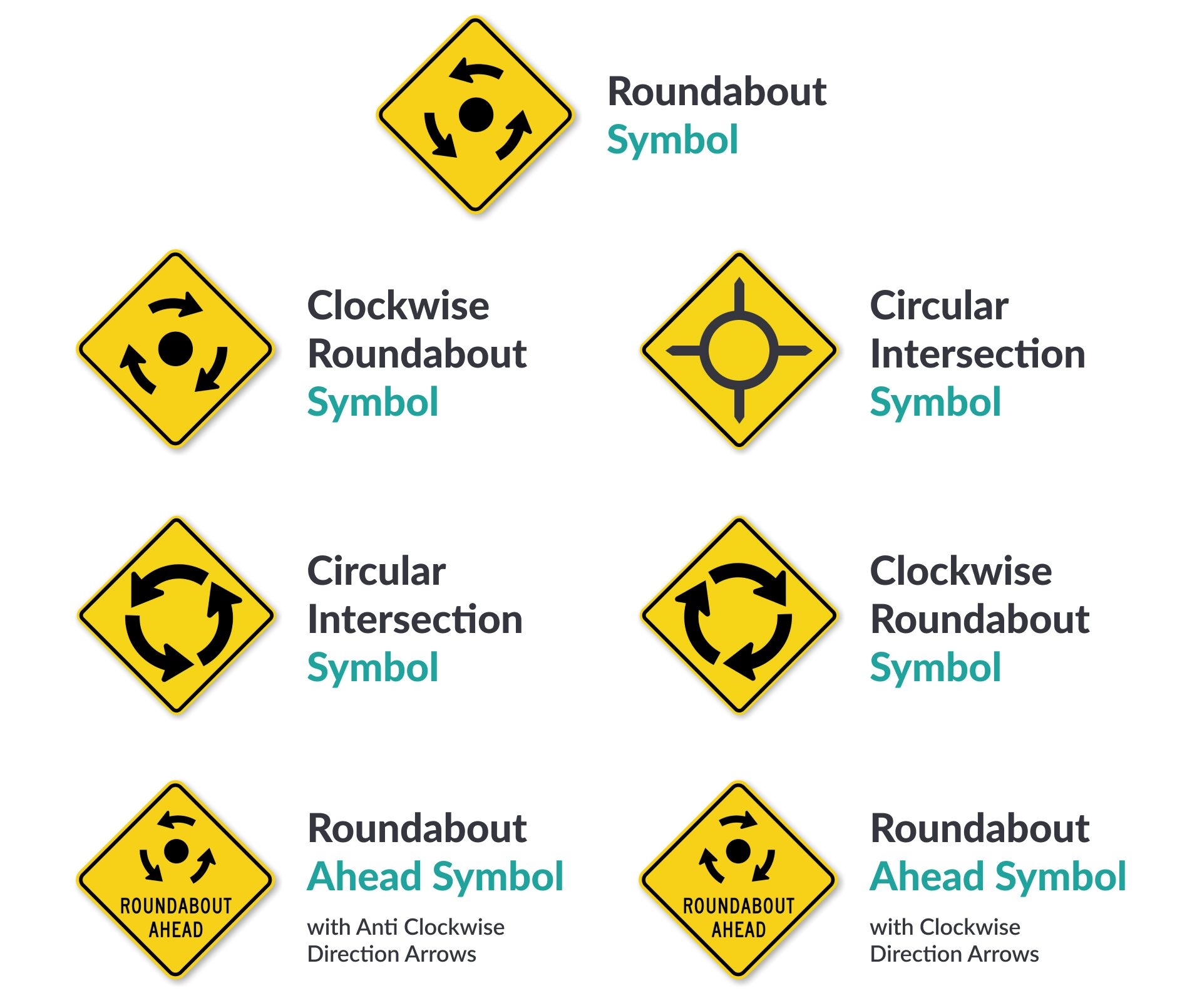
Multi-lane vs. Single-lane Roundabouts
Multi-lane and single-lane roundabouts adhere to the same traffic rules. However, in multi-lane roundabouts, drivers must choose their entry lane based on their intended exit. Thus, to turn right at the intersection, a driver must select the right lane.
Why Roundabouts are Useful

- Enhanced Safety: Roundabouts minimize the risk of severe injuries from right-angle, head-on, and high-speed collisions and feature crosswalks set further from entering traffic, providing safer pedestrian routes.
- Boosted Traffic Flow: The yield-at-entry rule in roundabouts facilitates uninterrupted traffic flow and reduces unnecessary wait times.
- Diverse Circulation: Roundabouts are important for intersections used by large trucks, allowing them to navigate easily.
- Improved Sustainability: Continuous movement reduces vehicle idling, leading to lower emissions and better air quality. Also, fewer stops minimize roadway wear, prolonging its durability.
How to Use a Roundabout
Turning right.

- Choose the right-hand lane unless road markings indicate otherwise.
- Activate the right turn signal before entering.
- Keep the vehicle in the right lane and exit.
- Deactivate the right turn signal.
Going Straight

- Select either the left or right lane.
- Don’t activate any turn signals before entering.
- As you approach the intended exit, activate the right turn signal.
- Exit and deactivate the right turn signal.
Turning Left

- Enter the left lane, respecting all signage and road markings.
- Activate the left turn signal before entering.
- Remain in the left lane, following the roundabout’s curve.
- Approaching the exit, activate the right signal.
- Exit and deactivate the turn signal.
Making U-turns

- Select the left lane, adhering to road markings.
- Circulate in the left lane, passing the first and second exits.
- Nearing the third exit (from your initial entry point), activate the right turn signal.
- Leave the roundabout on the third exit and deactivate the turn signal.
When leaving the roundabout, check the mirrors and blind spots to make sure you can exit safely. If it’s unsafe to exit, circle around the roundabout and try again. As you leave, join traffic flow at a safe speed, and keep an eye on road signs and anyone on foot or bike.
Common Mistakes to Avoid in a Roundabout
Not yielding the right of way.
- Traffic Flow Disruptions: By not yielding, drivers disrupt the smooth flow of traffic, leading to sudden braking or swerving.
- Accident Risks: When multiple vehicles enter the roundabout simultaneously, not yielding the right of way can lead to T-bone collisions.
- Road User Conflicts: Failure to yield puts vulnerable road users crossing the roundabout at risk.
Speeding or Stopping
By speeding up, drivers won’t have enough time to yield to other vehicles or navigate the roundabout correctly, which leads to lane confusion and right-of-way issues.
Drivers are advised to maintain a speed limit of 15-25 mph, depending on traffic conditions and visibility. But even in heavy traffic or low visibility, stopping inside a roundabout is prohibited, as this disrupts the movement and potentially leads to collisions.
Changing Lanes
Lane changes not only disrupt the movement but also increase collision risks. Drivers should select the appropriate lane for their intended exit before entering the roundabout.
How to Change a Lane Safely
- Check Surroundings: Ensure a clear view of adjacent lanes and consistently use mirrors.
- Signal Early: Turn on your indicator to show the lane change intention, providing a warning to drivers behind.
- Monitor Blind Spots: Regularly check for not immediately visible vehicles.
- Change Decisively: When a safe gap emerges, change your lane smoothly without hesitation.
Roundabout vs. Traffic Circle
Master Roundabout Rules for your Driver’s Test
Need a sure way to nail the roundabout section of your DMV driving test? Zutobi has your back! Our app gives not only basic knowledge but also highlights specifics like signaling accurately to exit roundabouts. Get started with Zutobi today and empower your test preparation with targeted and user-friendly learning.

550+ exam-like questions
All you need to ace your test
Perfect for first-timers, renewals and senior citizens
Recommended articles

Zutobi 2024 Holiday Report: The Deadliest Holidays to be Driving
Holidays are meant to be moments of joy and celebration, but amidst the festivities, there are hidden dangers that we often overlook. every year, as countless americans hit the road to enjoy their well-deserved breaks, they unwittingly encounter risks that can turn these happy occasions into tragic events. between 2018 and 2022, an alarming 11,058 […].
Driving School Costs Report – The Cheapest and Most Expensive States
For many, the ability to drive is not just about mobility—it’s a rite of passage that symbolizes freedom and the thrill of charting one’s own course. the anticipation of sitting behind the wheel for the first time is a universal dream, yet for many aspiring drivers in the united states, this dream comes with variable […].

Distracted Driving Report – The States With the Least and Most Distracted Driving
In april 2024, the national highway traffic safety administration (nhtsa) released data for 2022 that illustrated traffic deaths due to distracted driving increased by 12 percent from 2020 but decreased compared to 2021 to 6%. every year, thousands of drivers and passengers are fatally injured as a result of distracted driving. in 2022, roughly 2,109 […].
Ace your DMV test, guaranteed
Get started
- Learner’s Permit Ultimate Guide
- Driving Test Ultimate Guide
- Traffic Lights Guide
- How to Pass the DMV Permit Test
- How to Pass the Driving Test
- Common Reasons For Failing the Road Test
- International Driver’s Permit Guide
- Driver’s License Renewal
- How to Get Your US Driver’s License
- How to Prepare for Your Road Test
- How to Get a Driver’s Permit
- Behind-The-Wheel training
- Terms & conditions
- Privacy policy
- Do Not Sell My Personal Information
- Subscription terms
- Terms & policies
- Car Practice Tests
- CDL Practice Tests
- Motorcycle Practice Tests
- Credit cards
- View all credit cards
- Banking guide
- Loans guide
- Insurance guide
- Personal finance
- View all personal finance
- Small business
- Small business guide
- View all taxes
You’re our first priority. Every time.
We believe everyone should be able to make financial decisions with confidence. And while our site doesn’t feature every company or financial product available on the market, we’re proud that the guidance we offer, the information we provide and the tools we create are objective, independent, straightforward — and free.
So how do we make money? Our partners compensate us. This may influence which products we review and write about (and where those products appear on the site), but it in no way affects our recommendations or advice, which are grounded in thousands of hours of research. Our partners cannot pay us to guarantee favorable reviews of their products or services. Here is a list of our partners .
My Travel Secret For Not Overpacking? The 10-$10 Rule

Many, or all, of the products featured on this page are from our advertising partners who compensate us when you take certain actions on our website or click to take an action on their website. However, this does not influence our evaluations. Our opinions are our own. Here is a list of our partners and here's how we make money .
When traveling, packing less makes it easier to experience more. When you’re not weighed down by bulky bags, you have more freedom to jump on public transit or walk long distances without tiring. You’ll have fewer worries about repacking or losing items. With carry-ons only, you’ll avoid checked bag fees , waiting at the luggage carousel and the risk of lost luggage .
If you travel backpack-only, you'll be forced me to leave even more at home than you otherwise would with a full suitcase. It means sacrificing just-in-case items.
And that’s where my 10-$10 rule comes in.
What is the 10-$10 rule?
The 10-$10 rule is a packing strategy that helps you decide what to bring and what to leave behind. The premise is straightforward: If you can acquire a just-in-case item upon arrival for less than $10 and within 10 minutes, don’t pack it.
For cheap, small items that you’ll absolutely use — say a toothbrush, deodorant or underwear — pack them regardless. But for large or just-in-case items, buy them upon arrival, granted they cost less than about $10 and are easily purchasable within 10 minutes.
Under the 10-$10 rule, items you generally shouldn’t pack include:
Books (perhaps pack one, but will you really read that second one?).
First-aid kits.
Over-the-counter medications that you only sometimes use (e.g. antacid tablets or ibuprofen).
Weather-contingent items like ponchos and umbrellas (particularly if it’s not even rainy season).
Of course, the 10 minutes is key. There probably aren't drugstores in the wilderness, in which case packing something like a first-aid kit for a camping trip can make sense.
I’ve come up with this rule over the years of traveling carry-on only , and then progressing to backpack-only. When all your possessions are on your back, overpacking is not just unnecessary weight, but it makes it especially tough to sift through the items you really need.
Make the 10-$10 rule your own
The 10-$10 is more of a guideline than a rigid, one-size-fits-all rule. Embrace its spirit, and adjust the timing and dollar figure to your liking. Factors you consider might include:
A single, able-bodied adult might easily pop into a store and make a quick purchase. Others who are less mobile, or families with kids, might find that a single convenience store run exceeds 10 minutes, in which case packing more from home makes sense.
I sometimes make exceptions for an item’s size depending on the likelihood of using it.
Antihistamine cream is small and easy to pack, but I’ll never know whether I need it for a bug bite until it happens. Though such an item might never get used, I’ll more likely use it on a lakefront vacation in Florida than a trip in downtown Denver, where high elevations make it relatively bug-free.
Meanwhile, bulky items like beach towels never make the cut.
For budget-conscious travelers who can’t afford inflated hotel gift shop prices, the $10 threshold might be too high. Adjust it according to the flexibility of your budget.
As my own savings account has grown, I’m more willing to push the $10 rule higher. But in my younger years, my $10 rule was more like a $3 rule. Back then, I was more likely to pack a just-in-case umbrella, because the thought of forking over cash amidst a downpour felt wasteful. These days, I’m usually willing to gamble that it won’t rain.
Your own flexibility
If you’re picky, realize that it might take more than 10 minutes to find the item you want, in which case the 10-$10 rule doesn’t apply. I’m generally okay using any sort of skincare products. But if you demand a specific brand, pack your own.
And in some situations, like traveling with babies, taking 10 minutes to track down something like diaper cream might not be worth it when you could have packed it from home. The 10-$10 rule isn’t for you.
Items that make the 10-$10 cut on one trip might not on another. In New York City, where there’s no shortage of retailers, I’m more willing to underpack. That’s less often the case on trips to small towns or national parks where storefronts are limited.

Don’t overpack, but don’t overshop either
It’s usually okay to spend a little more than you would to buy the same things at home. I don’t mind paying the markup for sunscreen sold on the beach versus dealing with checked luggage to pack sunscreen from home.
On the other hand, watch out for wasteful spending. Once you’ve found a cheap souvenir stall, it can be tempting to buy anything under $10 — like fanny packs, sunglasses and hats. Don’t overlook the minimalist spirit of the 10-$10 rule, which is not only packing what you absolutely need — but also only buying what you absolutely need.
Benefits of the 10-$10 rule
Packing light taught me that I often don’t even need stuff I thought I did.
Hotels often supply items you might’ve packed anyway
Many hotels these days are tightening up on the free toiletries left on your bathroom counter, presumably to mitigate waste. But often, hotels still offer those freebies — you just have to ask.
On a recent stay at the Hotel Virginia Santa Barbara in Santa Barbara, Calif., the lobby attendant gave me complimentary toiletries like toothpaste and razors. I was delighted by the complimentary sunscreen at the Halepuna Waikiki by Halekulani in Honolulu.
Even at Disneyland, I’ve picked up free bandages for my blistered feet at a first aid station in the park.
Most hotels and vacation rentals provide irons, hairdryers and towels, so definitely don’t pack those bulky items. Some also offer items like robes and umbrellas.
You net a great souvenir
On a trip to Thailand, I intentionally under-packed. Buying a sundress, shirts, sandals and floppy hat from vendors who lined the beach was all part of the experience. Plus, they’re functional souvenirs that I truly love.
How to maximize your rewards
You want a travel credit card that prioritizes what’s important to you. Here are some of the best travel credit cards of 2024 :
Flexibility, point transfers and a large bonus: Chase Sapphire Preferred® Card
No annual fee: Wells Fargo Autograph℠ Card
Flat-rate travel rewards: Capital One Venture Rewards Credit Card
Bonus travel rewards and high-end perks: Chase Sapphire Reserve®
Luxury perks: The Platinum Card® from American Express
Business travelers: Ink Business Preferred® Credit Card
On a similar note...

Funds “Travel” Regulations: Questions & Answers
The following is revised guidance to financial institutions on the transmittal of funds "Travel" rule. This guidance updates the document “Funds ‘Travel’ Regulations: Questions & Answers” issued in 1997. It includes a parenthetical at the end of each answer indicating the date the answer was issued.
1. Are all transmittals of funds subject to this rule?
No. Only transmittals of funds equal to or greater than $3,000 (or its foreign equivalent) are subject to this rule, regardless of whether or not currency is involved. In addition, transmittals of funds governed by the Electronic Funds Transfer Act (Reg E) or made through ATM or point-of-sale systems are not subject to this rule. (January 1997)
2. What are the "Travel" rule's requirements?
All transmittor's financial institutions must include and send the following in the transmittal order:
- the name of the transmittor
- the account number of the transmittor, if used
- the address of the transmittor
- the identity of the transmittor's financial institution
- the amount of the transmittal order
- the execution date of the transmittal order
- the identity of the recipient's financial institution
and, if received:
- the name of the recipient
- the address of the recipient
- the account number of the recipient, and
- any other specific identifier of the recipient.
An intermediary financial institution must pass on all of the above listed information, as specified in the travel rule, it receives from a transmittor's financial institution or the preceding intermediary financial institution (exceptions are noted below, in FAQ #3), but has no general duty to retrieve information not provided by the transmittor's financial institution or the preceding intermediary financial institution.
An intermediary financial institution may receive supplementary information about a payment beyond the information the travel rule requires to be sent to the next financial institution in the payment chain. For example, a payment order may contain additional information about the payment or the parties to the transaction. Due to differences in format and detail included in different systems, such as Fedwire, CHIPS, SWIFT and proprietary message formats, this additional information may not be readily transferable to the format used to send a subsequent payment order. In that event, the sending intermediary institution would be in compliance with the travel rule as long as all of the information specified in the travel rule was included in the subsequent payment order. The information does not have to be structured in the same manner or appear in the same format so long as all of the information required by the travel rule is included. For example, if certain information specified in the travel rule was present in two or more fields in the payment order received, that information need only be included once in the payment order sent to satisfy the requirements of the travel rule.
Intermediary financial institutions in receipt of additional information not required by the travel rule should note that, while compliance with the travel rule is accomplished by inclusion of the information identified in the rule, other monitoring and reporting requirements may apply to additional information and nothing in this FAQ relieves a financial institution of any of its duties with regard to other requirements. In addition, as a matter of risk management, an intermediary financial institution may choose to provide a receiving financial institution supplemental information about a payment and the parties involved. Currently, limited interoperability between systems may prevent a bank from choosing to include certain supplementary information in a payment order. These limitations, however, may be temporary as systems develop.
Moreover, if any lawful order is received at, or if a request from another financial institution is made to a recipient's financial institution, all financial institutions must go back to the transmittor's financial institution, or any other preceding financial institution, if the transmittor's financial institution is unknown, and retrieve information required by the travel rule not included in the transmittal of funds due to system limitations. (Updated November 2010)
3. Are there any exceptions to these requirements?
Yes. If the transmittor and the recipient are the same person, and the transmittor's financial institution and the recipient's financial institution are the same domestic bank or domestic securities broker, the transaction is excepted from the requirement contained in these new rules.
In addition, if both the transmittor and the recipient, that is, as defined, the beneficial recipient, are any of the following, then the transmittal of funds is not subject to these rules:
- Domestic bank;
- Wholly owned domestic subsidiary of a domestic bank;
- Domestic broker or dealer in securities;
- Wholly owned domestic subsidiary of a domestic broker or dealer in securities;
- Domestic futures commission merchant or an introducing broker in commodities;
- Wholly owned domestic subsidiary of a domestic futures commission merchant or an introducing broker in commodities;
- The United States;
- Federal agency or instrumentality;
- State or local government; State or local agency or instrumentality; or
- Domestic mutual fund. (Updated November 2010)
4. Does this rule require any reporting to the government of any information?
No. However, if a transmittal of funds seems to the financial institution to be suspicious, then a Suspicious Activity Report is required, if the financial institution is subject to the Bank Secrecy Act's suspicious activity reporting requirement. (January 1997)
5. How long does a financial institution have to keep records required by these new rules?
Five (5) years. (January 1997)
6. What is the benefit of this rule to the public?
Law enforcement authorities have identified instances to the Treasury in which records maintained by financial institutions were incomplete or insufficient and thereby hampered criminal investigations. In addition, in certain criminal investigations, financial institutions were unable, on a timely basis, to provide law enforcement authorities with useful financial records of transmittals of funds. This rule was created to ensure that in criminal investigations, as well as tax or regulatory proceedings, sufficient information would be available to quickly enable authorities to determine the source of the transmittal of funds and its recipient. Finally, it is anticipated that this rule will more easily permit law enforcement authorities to determine the parties to a transaction. (January 1997)
7. What is a financial institution for the purposes of this rule?
The term "financial institution" includes: banks; securities brokers or dealers; casinos subject to the Bank Secrecy Act; money transmitters, check cashers, currency exchangers, and money order issuers and sellers subject to the Bank Secrecy Act; futures commission merchants and introducing brokers in commodities; and mutual funds. Please see 31 CFR 103.11 for more information. (November 2010)
8. Does this rule treat banks and non-bank financial institutions differently?
No. Banks and non-bank financial institutions are treated identically under the Travel rule. (January 1997)
9. What are some of the implications of the Travel rule for financial institutions subject to this rule?
The most important implication is that financial institutions must be aware that if a transmittal of funds involves both bank and non-bank financial institutions, each financial institution must carefully analyze and understand all of the definitions that apply to its role in the transmittal of funds. This is important because the rule's requirements on financial institutions differ, depending on what role a financial institution plays in a transmittal of funds.
For example, in a situation in which the customer of a securities broker initiates a transmittal of funds that is sent through a bank, that bank is an intermediary financial institution for the purposes of the Travel rule.
The next important implication is that financial institutions must carefully understand the role of the succeeding financial institution in the chain of each transmittal of funds, particularly where a transmittal of funds moves from a bank to a non-bank, or vice versa. This is important because the Travel rule's requirement to pass information to the next financial institution in the chain implicitly requires financial institutions that carry out transmittals of funds to coordinate the transfer of information required by this new rule.
Finally, as the range of services offered by financial institutions expands, financial institutions must recognize that a single transmittal may involve two or more funds transfer systems. In such cases, it is important that financial institutions understand their roles in such a complex transmittal of funds, because their duties under this rule arise from their role(s) in the transmittal of funds. (January 1997)
10. What is the relationship between the terms used in this rule and those used within Article 4A of the Uniform Commercial Code (UCC)?
This rule uses terms that are intended to parallel those used in UCC Article 4A, but that are applicable to all financial institutions, as defined within the Bank Secrecy Act's implementing regulations.
(January 1997)
11. Do the terms created in this regulation apply to transmittals of funds to or from anywhere in the world?
Yes. However, the requirements of the Bank Secrecy Act apply only to activities of financial institutions within the United States. Thus, for example, part, but not all, of an international transmittal of funds can be subject to the Travel rule. (January 1997)
12. Is this rule limited to wire transfers?
No. The term transmittal of funds includes other transactions and transfers in addition to wire transfers or electronic transfers. (January 1997)
13. What are examples of transmittals of funds that are not wire transfers?
Financial institutions sometimes carry out transmittals of funds using correspondent accounts or journal entry transfers such as "due from" and "due to" accounts. In such cases, covered transmittals of funds have occurred even though no wire transfer has occurred.
In addition, a check can be the transmittal order within a transmittal of funds. This limited case occurs when Customer 1 goes into Financial Institution A and orders a transmittal of funds be sent to Customer 2 at Financial Institution B. Financial Institution A, perhaps because it is a small financial institution or because the transaction involves a function (such as a trust) that is segregated from the rest of the financial institution, sends a check, payable to Financial Institution B, directly to Financial Institution B, and does not send the check directly to Customer 1 or to Customer 2. This check must be Financial Institution A's own check (however, it need not be drawn on Financial Institution A), and not the check of the customer. This check contains accompanying instructions to have Financial Institution B subsequently credit Customer 2's account. In such a case, the check and its instructions are the transmittal order effecting a transmittal of funds. (January 1997)
14. How should aggregated transmittals of funds be treated?
This is a situation where a financial institution aggregates many separate requests for transmittals of funds into one combined transmittal of funds.
Whenever a financial institution aggregates separate transmittors from separate transmittals of funds, the transmittor's financial institution itself becomes the transmittor, for the purpose of the Travel rule. Conversely, any time a financial institution combines separate recipients from separate transmittals of funds, the recipient's financial institution itself becomes the recipient, for the purpose of the Travel rule.
For example, if a money transmitter has five (5) customers who wish to have funds disbursed to five separate recipients at a separate money transmitter, and the money transmitter uses a bank to carry out the movement of funds, the bank might aggregate the five (5) separate customers. In such an instance and for the purposes of the Travel rule, the bank may list as transmittor the transmittors’ money transmitter, and as recipient the recipients' money transmitter. However, the transmittors' money transmitter itself is independently obligated to make travel the required information to the recipients' money transmitter. Thus, the information is still required to travel in an aggregated transmittal of funds, although not necessarily in the same manner or by the same parties as in a non-aggregated transmittal of funds. (January 1997)
15. How should joint party transmittals of funds be treated?
For example, Ms. A and Ms. B, sisters with different names and addresses, jointly act as the transmittor or as the recipient. In such cases, it may be impossible to transfer all the information required under the Travel rule. In this instance, the Treasury suggests the following:
When a transmittal of funds is initiated by more than one transmittor, or sent to more than one recipient, the transmittor's financial institution may select one transmittor, or one recipient, as the person whose information must be passed under the “Travel” rule. In all cases involving a transmittal of funds from a joint account, the account holder that ordered the transmittal of funds should be identified as the transmittor on the transmittal order. Please note that for the Joint Rule [31 CFR 103.33(e) and (f)], records must still be kept on all parties. (January 1997)
16. How should a financial institution treat a customer who uses a code name or a pseudonym, or a customer who has requested that the financial institution hold his/her mail?
For purposes of compliance with the Travel rule, the use of a code name or pseudonym is prohibited. In all such cases, the financial institution must use the customer's true name, and the customer's address. Customers may use abbreviated names, names reflecting different accounts of a corporation, as well as trade and assumed names, or names of unincorporated divisions or departments of businesses.
There may be legitimate reasons for having the financial institution's address serve as the transmittor's mailing address, such as where a customer has requested that the financial institution hold his/her mail. Consequently, so long as the financial institution maintains on file the transmittor's true address and such true address is retrievable upon request by law enforcement, the financial institution may comply with Section 103.33(g) by forwarding with the transmittal order the customer’s mailing address that is maintained in its automated Customer Information File (CIF) (even if that address happens to be the bank's own mailing address). (Updated November 2010)
17. To whom can a financial institution go should it have further questions?
Any financial institution may contact its primary Bank Secrecy Act examination authority, or the Treasury Department's Financial Crimes Enforcement Network can be contacted regarding questions on the Bank Secrecy Act rules at (800) 949-2732. (Updated November 2010)
The FinCEN Travel Rule
- February 25, 2021
- AML Compliance , Banks , Blog , Casino and Gaming , FinTechs , MSBs
Disclaimer: The contents of this article are intended to provide a general understanding of the subject matter. However, this article is not intended to provide legal or other professional advice, and should not be relied on as such.
The FinCEN “Travel Rule” has many requirements and nuances that can challenge and confuse new and seasoned AML compliance professionals alike. From the basics of what types of transactions fall under the Rule, to mandatory versus optional data requirements, to its many exemptions – as well as the nuances addressed by subsequent FinCEN guidance not contained in the Rule itself – compliance professionals need to understand the details of this longstanding Bank Secrecy Act (BSA) regulation.
This article begins with a review of the fundamentals of the FinCEN Travel Rule , and why compliance is so important to anti-money laundering efforts. Learn about the nuances of complying with the Travel Rule, including a discussion of pending changes to the Travel Rule in an October 2020 Notice of Proposed Rulemaking; Fedwire versus Travel Rule requirements; aggregated funds transfers; Originator name issues; and transfers by non-customers.
What is the FinCEN Travel Rule?
In January 1995, the Board of Governors of the Federal Reserve and FinCEN jointly issued a Rule for banks and other nonbank financial institutions, relating to information required to be included in funds transfers. The Rule is comprised of two parts – the Recordkeeping Rule, and what’s come to be known as the Travel Rule. The Travel Rule was promoted by FinCEN, in keeping with their mandate to enforce the Bank Secrecy Act .
The Recordkeeping Rule and the Travel Rule are complementary. The Recordkeeping Rule requires financial institutions to collect and retain the information that in turn, per the Travel Rule, must be included with a funds transfer and passed along – or “travel” – to each successive bank in the funds transfer chain. The Recordkeeping Rule does however serve other purposes besides ensuring that information is available to include with funds transfers.
The terms “transfer” and “transmittal” are used throughout this regulation. The distinction between these two terms is simple: a bank performs transfers, and a non-bank financial institution performs transmittals. The term “transfer” will primarily be used from this point on to refer to both types of transactions.
The Underlying Objective
Fund transfers have been the tool of choice for money laundering, fraud, and much more, for decades. As FinCEN’s mission is to implement, administer, and enforce compliance with the Bank Secrecy Act, it has the authority to require financial institutions to keep records that, according to FinCEN, have a high degree of usefulness in criminal, tax, or regulatory investigations or proceedings, or even in intelligence or counterintelligence matters when terrorism is involved.
Ultimately, the Recordkeeping and Travel Rule is primarily designed to help law enforcement to detect, investigate and prosecute money laundering and financial crimes, by preserving the information trail about who’s sending and receiving money through funds transfer systems. In other words, it helps them follow the money.
Transactions Subject to the Recordkeeping and Travel Rule
The Recordkeeping and Travel Rule states that it applies to funds transfers. The definition of a funds transfer is very important, as highlighted later in the discussion of the most recent Notice of Proposed Rulemaking.
The Rule defines a funds transfer as a series of transactions, beginning with the Originator’s payment order, made for the purpose of making a payment of money to the Beneficiary of that payment order.
Below is a basic illustration of a funds transfer. An Originator creates a Payment Order to pay money to a specific Beneficiary. The Originator delivers the Payment Order to his bank, which then passes on the Payment Order details to the bank holding the Beneficiary’s account. The funds transfer is complete when the Beneficiary’s Bank accepts the Payment Order on behalf of the Beneficiary.
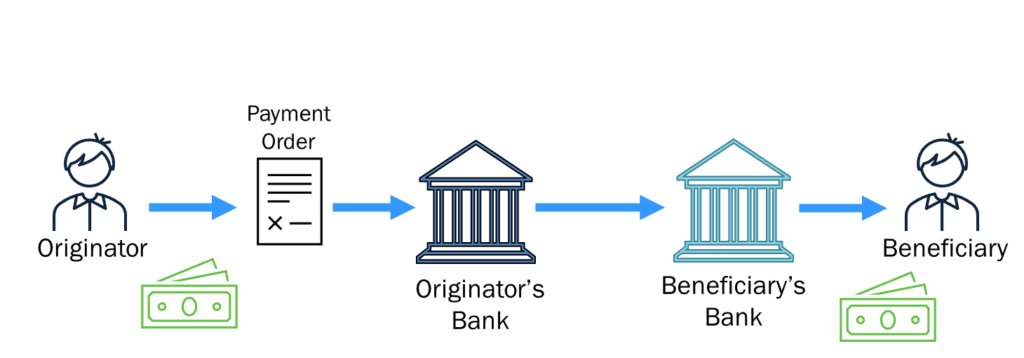
In today’s world, funds transfers are electronic, and a wire transfer is the most common form of electronic funds transfer. At its essence, a wire transfer is simply a message from one bank to another, passed through an electronic system, such as Fedwire, SWIFT , or CHIPS.

Electronic Funds Transfers That are Excluded
Besides wire transfers, there are many types of electronic funds transfers, or EFTs in use today. Although all are in essence funds transfers, these types of transactions are specifically excluded from the definition of a funds transfer or transmittal in the Recordkeeping and Travel Rule. Instead, these types of electronic funds transfers are defined in, and governed by, the Electronic Funds Transfer Act, otherwise known as Regulation E. [i] Currently, these are:
- ACH (automated clearing house) transactions
- ATM (automated teller machine) transactions
- Point of Sale (POS) transactions
- Direct deposits or withdrawals
- Telephone banking transfers
Terminology Review
The terminology used in the Recordkeeping and Travel Rule is in many cases unique. The more commonly-used terms when referring to wire transfers and other electronic funds transfers come from the Uniform Commercial Code’s Article 4A, which governs funds transfers. [ii]
Throughout this article, UCC 4A terminology will be used as it is more commonly understood:
* The spelling shown here is per the regulation; it is not the correct spelling of this word according to widely-accepted sources.
The term Sender per UCC 4A refers to the person who is delivering the Payment Order to the Receiving Bank. This person would typically be the Originator, but could potentially be a third party, as discussed further below.
Funds Transfer Data Requirements
The Rule divides the data requirements on a funds transfer into two groups: (1) data that is mandatory, and (2) data that, if the originator provides it , must be included.
First, the data that must be included on the funds transfer by the Originator’s Bank is:
- The Originator’s name
- The Originator’s address
- The Originator’s account number (if there is one)
- The identity of the Beneficiary’s Bank
- The payment amount
- The payment execution date
Typically, a bank will automatically populate the Originator’s name and address information on a wire transfer directly from the customer record. This is because it is very important that the Originator’s name reflects the actual party initiating the Payment Order. (This topic is explored further in the Deep Dives section below.)
The second group of data elements is optional – meaning, if the Originator provides any of this information, it must be included on the funds transfer record. This information includes:
- The Recipient’s (or Beneficiary’s) name
- The Beneficiary’s address
- The Beneficiary’s account number or other identifiers
- Any other message or payment instructions – what typically are entered in the freeform text fields on a wire transfer, such as the Originator to Beneficiary Information or OBI field on a Fedwire.
Even though this information is not mandatory per FinCEN’s Travel Rule requirements, nothing precludes a bank from mandating customers to supply it. From an operational perspective, at least the Beneficiary’s account number should be required information to minimize the risk that the transfer will be rejected and returned by the Receiving Bank as unpostable.
As well as being highly valuable to law enforcement, Beneficiary information is critical to a bank’s fraud detection , suspicious activity monitoring and sanctions compliance efforts. Without this information, detecting an unusual or suspicious wire transfer recipient, establishing a pattern of transaction activity to a particular recipient, or identifying a customer transaction with an OFAC-sanctioned party is impossible.
Exemptions from the Travel Rule
In addition to the types of EFTs that are not subject to the Rule (as they fall under the jurisdiction of Regulation E) there are several categories, or classes, of funds transfers that are exempt from FinCEN’s Travel Rule’s requirements. Specifically:
- A funds transfer that is less than $3,000.
- A funds transfer where the sender and the recipient are the same person . For example, if an individual is wiring money from her account at Bank A to her account at Bank B, Bank A does not have to obtain and retain the Travel Rule mandatory information for this transfer.
- A funds transfer made between two account holders at the same institution. Commonly known as a book transfer, this transaction is not processed through the Federal Reserve, but is simply a journal entry on the financial institution’s books.
- A bank, or a U.S. subsidiary thereof
- A commodities/futures broker, or a U.S. subsidiary thereof
- The U.S. government; a state or local government
- A securities broker/dealer, or a U.S. subsidiary thereof
- A mutual fund
- A federal, state or local government agency or instrumentality
Nothing prevents a financial institution from ignoring these exemptions; the institution is free to follow the Recordkeeping and Travel Rule requirements with every funds transfer. Such a practice benefits all the financial institutions involved in the transaction, as well as law enforcement.
Recordkeeping and Travel Rule Enforcement
FinCEN enforcement actions over the years have never solely targeted violations of the Recordkeeping and Travel Rule. This is likely because as a matter of operational efficiency, financial institutions typically populate the basic mandatory information on all outgoing funds transfers and maintain records of such.
However, it is important not to overlook the other key element of the Recordkeeping and Travel Rule: records retrievability.
A financial institution may be approached by federal, state, or local law enforcement, its regulator, another regulatory agency, or by subpoena, to provide specific funds transfer records.
If the institution is the Originator’s Bank, the mandatory funds transfer information to be collected and retained (Originator name & address, etc.) must be retrievable upon request, based on the Originator’s name . If the Originator is the institution’s established customer, transaction retrieval by the Originator’s account number may also be requested. A Beneficiary’s Bank must be able to retrieve funds transfer records by the Beneficiary’s name, and if an established customer, also by account number.
The FinCEN Travel Rule requires all funds transfer records to be retained for a minimum of five years from the date of the transaction.
Once funds transfer records are requested, the Rule states they must be supplied within a reasonable period – which may likely be negotiated between the financial institution and the requestor.
The 120-Hour Rule
However, financial institutions should be aware of a lesser-known clause within Section 314 of the USA PATRIOT Act that could impact records retrieval. Commonly known as the 120 Hour Rule , it states that any information, on any account that is opened, maintained, or managed in the U.S. requested by a federal banking agency, must be provided by the financial institution within 120 hours (5 days) after receiving the request. Funds transfer records would likely fall within the scope of this Rule.
Anecdotally, regulators have not imposed the 120 Hour Rule often. Financial institutions should nevertheless be prepared to respond to regulatory or law enforcement requests as quickly and efficiently as possible. IRS and civil case subpoenas requesting funds transfer records also typically have a short response window.
Recordkeeping and Travel Rule Guidance: A Deep Dive
The following sections explore deeper topics relating to Recordkeeping and Travel Rule guidance, including:
- The October 2020 Joint Notice of Proposed Rulemaking impacting the Rule
- Fedwire versus the Travel Rule
- Originator name issues
- Aggregated funds transfers
- Funds transfers for non-customers
Joint Notice of Proposed Rulemaking
On October 23, 2020, the Board of Governors of the Federal Reserve and FinCEN issued a Joint Notice of Proposed Rulemaking (NPRM) to amend the Recordkeeping and Travel Rule regulations. Written comments on the Proposed Rule were due by the end of November 2020. The next step is a publication of the Final Rule, but FinCEN has not set a date for this.
According to the website Regulations.gov , 2,882 comments were submitted for the NPRM. Commenters ranged from major banking groups such as the American Bankers Association to private individuals. The comments were overwhelmingly negative.
The NPRM proposes two major changes, discussed below.
Reducing the Minimum Dollar Threshold for Recordkeeping and Travel Rule Compliance on Cross-Border Funds Transfers
Part 1 of the NPRM proposes reducing the $3,000 threshold for Recordkeeping and Travel Rule compliance to $250 for cross-border transactions. The threshold for domestic transactions would remain at $3,000.
While this change may not have a major impact on financial institutions that ignore the dollar threshold exemption, it would significantly impact those institutions that follow it. There are some interesting nuances in this proposed change regarding what is meant by “cross border.”
Initially, a “cross-border” transaction is defined as one that, “begins or ends outside of the United States.” The United States includes the 50 states, the District of Columbia, the Indian lands (as that term is defined in the Indian Gaming Regulatory Act), and the Territories and Insular Possessions of the United States. [iii]
A funds transfer would be considered to “begin or end outside the United States” if the financial institution knows, or has reason to know, that the Originator, the Originator’s financial institution, the Recipient/Beneficiary, or the Recipient/Beneficiary’s financial institution is located in, is ordinarily resident in, or is organized under the laws of a jurisdiction other than the United States. Furthermore, a financial institution would have “reason to know” that a transaction begins or ends outside the United States only to the extent such information could be determined based on the information it receives in the payment order or otherwise collects from the Originator.
The driving factor behind this regulatory change is the benefit to law enforcement and national security. FinCEN’s analysis of SAR filings , as well as comments collected by the Department of Justice from agents and prosecutors at the Federal Bureau of Investigation, the U.S. Drug Enforcement Administration, the Internal Revenue Service, the U.S. Secret Service, and U.S. Immigration and Customs Enforcement, all supported lowering (or eliminating altogether) the reporting threshold, in order to disrupt illegal activity and increase its cost to the perpetrators.
According to FinCEN and these other law enforcement agencies, cross-border funds transfers, and especially lower dollar transfers in the $200 to $600 dollar range, are being used extensively in terrorist financing and narcotics trafficking to avoid reporting and detection.
For those institutions that abide by the minimum reporting threshold, the new lower cross-border threshold presents operational and programmatic challenges. The distinction between a cross-border and a domestic transaction is not always clear. For example, if a financial institution has no direct foreign correspondent banking relationships, its cross-border funds transfers must flow through a U.S. intermediary institution, and therefore the Federal Reserve. Automated systems may interpret such transactions as domestic because the first receiving institution will always be U.S.-based.
Recordkeeping and Travel Rule Applies to Virtual Currency
The second element of the NPRM would make funds transfers involving convertible virtual currency (CVC) and other digital assets, to be subject to the Recordkeeping and Travel Rule. CVC, more commonly known as cryptocurrency or cyber-currency, is a medium of exchange with an equivalent value in currency or acts as a substitute for currency, but at present does not fall under the regulatory definition of “money” (also known as legal tender).
The Proposed Rule now defines CVC as money. This is significant because transfers of CVC now legally fall within the meaning of “a transfer of money” to which the Recordkeeping and Travel Rule applies.
The “why” behind this aspect of the Proposed Rule is the exponential growth in CVC use for money laundering, terrorist financing, organized crime, weapons proliferation, and sanctions evasion. CVC’s anonymity makes it particularly attractive for financial crime. Bad actors can convert illegal proceeds into virtual currency and then transmit it to any destination anonymously within seconds, where it is redeemed for cash again or converted to another form. This makes CVC a perfect mechanism for the layering phase of money laundering.
For more information, check out our blog on the crypto travel rule .
NPRM Background and the “FATF Travel Rule”
Events leading up to the NPRM provide an interesting background, especially as they are intertwined with global anti-money laundering efforts – specifically those of the Financial Actions Task Force (FATF) and what has come to be known as the “FATF Travel Rule.”
As virtual currency’s popularity began to grow exponentially, regulators in the United States and globally were caught off-guard. It was not well understood, and there were no real protocols in place to govern it. In March 2013 , FinCEN released initial guidance clarifying that virtual currency exchangers and administrators must register as money service businesses, pursuant to federal law. [iv]
In October 2018 , FATF published guidance that clearly defined just what are virtual assets and virtual asset service providers (VASPs). [v] FATF followed this up in February 2019 with a far-reaching Interpretive Note to Recommendation 15 (New Technologies), in a Public Statement titled “Mitigating Risks from Virtual Assets.” [vi]
This publication included two key proposals that generated backlash from the cryptocurrency sector:
For one, it proposed that VASPs should, at a minimum, be required to be licensed or registered in the jurisdiction(s) where they are created. As well, VASPs should be subject to effective systems for monitoring compliance with a country’s AML/CFT requirements, and be supervised by a competent authority – not a self-regulatory body.
Second, it introduced what’s come to be known as the FATF Travel Rule for funds transferred over $1,000 – specifically referencing virtual asset transfers. These requirements match up point-for-point with the United States Recordkeeping and Travel Rule in terms of required funds transfer data to be obtained, retained and passed on.
In May 2019 , FinCEN published lengthy and complex guidance [vii] effectively stating that CVC-based transfers processed by nonbank financial institutions that meet the definition of a money service business are subject to the Bank Secrecy Act (BSA), and thereby the Recordkeeping and Travel Rule. Furthermore, it clarified that a transfer of virtual currency involves a sender making a “transmittal order.”
One month later in June 2019 , the FATF formally adopted the proposals from their 2018 guidance by incorporating them into the FATF 40 Recommendations – specifically, Recommendation 16, Wire Transfers.
In October 2020, the Federal Reserve Board and FinCEN issued their Joint NPRM, which would codify their May 2019 guidance as well.
Fedwire vs. the FinCEN Travel Rule
With respect to the implementation and enforcement of the Recordkeeping and Travel Rule, there is an interesting disconnect between the two key divisions of the U.S. Treasury Department. FinCEN is tasked with administering and enforcing the BSA, of which the Recordkeeping and Travel Rule is a part. The Federal Reserve Banks, also part of the US Treasury Department, own and operate Fedwire , the country’s primary funds transfer service. Yet the Fedwire system does no validation whatsoever that funds transfers processed through it include the basic, mandatory information required by the Travel Rule. The only data elements required to process a Fedwire transfer are the sending and receiving banks’ Fed routing numbers, the transaction amount, and its effective date. [viii]
One might conclude that law enforcement could have much more information on funds transfers at its disposal if the federal government’s actual funds transfer system made that information required. Today, should an Originator’s Bank fail to include the Travel Rule’s mandatory information (Originator’s name and address, etc.) on a funds transfer, the Receiving Bank is under no obligation to return the transfer and request the mandatory information. Instead, the burden is solely on the Originator’s Bank to comply, and any subsequent Receiving Banks’ responsibility is simply to retain (and pass on, if necessary) the information received.
Aggregated Funds Transfers
A financial institution may aggregate, or combine, multiple individual funds transfer requests into a single, aggregated funds transfer/transmittal.
For purposes of the FinCEN Travel Rule, whenever a financial institution aggregates multiple parties’ transfer requests into one single transfer, the institution itself becomes the Originator. Similarly, if there are multiple Beneficiaries in this aggregated transfer, but all with accounts at the same Receiving institution, then that institution becomes the Beneficiary on the aggregated funds transfer.
Aggregated funds transfers are common with money service businesses , as illustrated here:

A money service business (MSB) in Texas has several transmittal orders from various individuals, who are all sending funds to recipients via one particular Mexican casa de cambio. The Texas MSB aggregates these transactions into a single transmittal order, submitted to the MSB’s bank in Texas, for which the Beneficiary is the Mexican casa de cambio. This transmittal order does not identify the individual Originators or Beneficiaries of the underlying transfers. The Texas bank passes on the aggregated transmittal order to the Mexican bank holding the account of the casa de cambio. Once this funds transfer is complete, the casa de cambio pays the Mexican recipients, based on separate individual transmittal orders it received directly from the Texas MSB.
In this aggregated funds transfer scenario, the Originators’ payments are completed through a combination of individual transmittal orders between the senders and recipients, and an aggregated funds transfer between the MSB and the casa de cambio.
To summarize, the Recordkeeping and Travel Rule requirements for the Texas MSB and its Texas bank are as follows.
The MSB must keep a record of each customer’s individual transmittal order. The MSB is the Originator’s Bank, and the individual sender is the Originator. The Beneficiary is the individual who will receive the money, and the Beneficiary’s Bank is the Mexican casa de cambio.
The Texas bank must retain and pass on the information on the aggregated funds transfer between the MSB and the casa de cambio. On this funds transfer record, the Originator is the Texas MSB, the Texas bank is the Originator’s Bank, the Mexican casa de cambio is the Beneficiary, and its bank is the Beneficiary’s Bank.
Originator Name Issues
The Originator’s full true name is a required data element per the Recordkeeping and Travel Rule. A financial institution will typically populate the Originator’s name and address information on a funds transfer directly from its customer record.
A financial institution may be faced with a situation where a customer does not want his/her/their actual name to be present on a funds transfer.
For example, a customer may ask the financial institution to replace the Originator name on a funds transfer with that of some other party. Oftentimes, the customer is sending funds from their own account on behalf of someone else. Individuals as well as business entities may make such a request, for a variety of underlying reasons.
Changing an Originator’s name from that of the account holder to that of a third party is clearly a violation of the spirit of the Travel Rule, although not specifically addressed within it. Further, it exposes the financial institution to risks of abetting fraud, tax evasion, and other illicit activities.
The FinCEN Travel Rule does, however, specifically prohibit the use of a code name or pseudonym in place of an individual Originator’s true name. However, there are some exceptions to this with respect to commercial/business customers. For instance, a business may have several accounts, each of which is titled in a manner that reflects the purpose of the account – such as “Acme Corporation Payroll Fund.” Use of an account name that reflects its commercial purpose is acceptable for an Originator name under the Travel Rule.
Other acceptable Originator names for business customers are names of unincorporated divisions or departments, trade names, and Doing Business As (DBA) names, such as these examples:
- “Giant Inc Engineering Division”
- “McDonald’s” (a trade name for the McDonald’s Corporation)
- “Sue’s Flowers” (the DBA name for a sole proprietorship owned by Sue Smith)
Joint Accounts
When a funds transfer is made from a joint account, technically both account holders are the Originators. However, automated funds transfer systems, including Fedwire, do not provide space for more than one Originator name and address. FinCEN provides financial institutions with a solution: [ix] simply identify the Originator on the transfer as the joint account holder who requested it.
Funds Transfers for Non-Customers
Additional rules apply when a financial institution accepts a funds transfer order from a party that is not an established customer (i.e., a non-customer).
If the payment order is made in person by the Originator, the financial institution must verify his/her identity, and obtain and retain the following information:
- Originator’s name and address
- Type of identification document reviewed, and its number and other details (e.g., driver’s license number, state where issued)
- The Originator’s tax ID number, or, if none, an alien identification number or passport number and country of issuance. Should the Originator state that he/she has no tax ID number, a record of this fact should also be retained.
If the person delivering the payment order is not the Originator, the financial institution should record that person’s name, address, and tax ID number (or alternative as described above), or note the lack thereof. The institution should also request the actual Originator’s tax ID number (or alternative as described above) or a notation of the lack thereof. The institution must also keep a record of the method of payment for the funds transfer (such as a check or credit card transaction).
- The Recordkeeping and Travel Rule is a joint regulation under the Bank Secrecy Act, issued by the Federal Reserve Board and FinCEN.
- Record retrieval is equally important as record creation. Financial institutions should ensure full records of all outgoing and incoming funds transfers are retained for five years and can be retrieved by Originator name or account number (for established customers).
- Exemptions to the Rule, such as funds transfers under $3,000, are not mandatory . Financial institutions may choose to fully comply with the Recordkeeping and Travel Rule for every funds transfer sent or received, no matter the dollar amount or the parties involved.
- If the Originator is not required to provide the Beneficiary’s name, address, and account number on every wire transfer, this will have a significant detrimental impact on the financial institution’s suspicious activity monitoring, fraud detection, and sanctions compliance efforts.
- The October 2020 Notice of Proposed Rulemaking impacts cross-border funds transfers and the virtual currency industry. No date has yet been set for the publication of a Final Rule.
- A customer should not be allowed to substitute another name for the Originator on an outgoing funds transfer, as this exposes the financial institution to the risk of acting as a conduit for fraud, tax evasion, and other illicit activity, no matter how innocent or legitimate the customer’s request may seem.
- A financial institution that sends or receives aggregated funds transfers, or transfers for non-customers, should examine its existing processes to ensure compliance with the special rules for these activities.
How Alessa Can Help
Alessa is an integrated AML compliance software solution for due diligence, sanctions screening , real-time transaction monitoring , regulatory reporting and more. The solution integrates with existing core systems and includes:
- Identity verification and customer due diligence for KYC/KYB
- Real-time transaction monitoring and screening
- Sanctions, PEPs, watch list, crypto and other forms of screening
- Configurable risk scoring
- Automated regulatory reporting
- Advanced analytics like anomaly detection and machine learning
- Dashboards, workflows and case management
With Alessa, customers can monitor their wire transactions and ensure that the appropriate process is in place to collect and record the right information in order to comply with regulatory bodies. Contact us today to see how we can help you implement or enhance the AML program at your financial institution to comply with mandates such as the FinCEN Travel Rule.
[i] 15 USC 1693 et seq.
[ii] The Uniform Commercial Code (UCC) is a comprehensive set of laws governing all commercial transactions in the United States. It is not a federal law, but a uniformly adopted state law. Uniformity of law is essential in this area for the interstate transaction of business. Source: Uniform Law Commission, www.uniformlaws.org
[iii] 31 CFR 1010.100(hhh)
[iv] Financial Crimes Enforcement Network. “Application of FinCEN’s Regulations to Persons Administering, Exchanging, or Using Virtual Currencies.” FIN-2013-G001, 18 March 2013.
[v] Financial Actions Task Force. “Regulation of Virtual Assets.” 19 October 2018.
[vi] Financial Actions Task Force. “Public Statement – Mitigating Risks from Virtual Assets.” 22 February 2019.
[vii] Financial Crimes Enforcement Network. “Application of FinCEN’s Regulations to Certain Business Models Involving Convertible Virtual Currencies.” FIN-2019-G001, 9 May 2019.
[viii] Various codes are also required data on a Fedwire transfer; however, these codes are for system processing purposes and have no relation to originator or beneficiary data.
[ix] Financial Crimes Enforcement Network. “Funds ‘Travel’ Regulations: Questions and Answers.” FIN-2010-G004, 9 November 2010.
Schedule a free demo
See how alessa can help your organization.
100% Commitment Free
Recent Posts

5 Best Practices to Maintain FCA Compliance
Learn five best practices to ensure FCA compliance and boost trust and stability in financial markets.

FINRA Rule 2090 and 2111: A Comprehensive Guide
Learn about FINRA Rules 2090 and 2111, which require firms to know their customers (KYC) and make suitable investment recommendations.

FINRA Compliance: A Guide for Financial Firms
Learn about key FINRA rules, AML best practices, and the importance of compliance for financial firms in this comprehensive guide.
Sign up for our newsletter
Join the thousands of AML professionals who receive our monthly newsletter to stay on top of what is happening in the industry. You may opt-out at any time.
Customer Support
Customer Support Portal
Copyright © 2024 Alessa Inc.
Please fill out the form to access the webinar:

An official website of the United States government
Here’s how you know
Official websites use .gov A .gov website belongs to an official government organization in the United States.
Secure .gov websites use HTTPS A lock ( Lock A locked padlock ) or https:// means you’ve safely connected to the .gov website. Share sensitive information only on official, secure websites.
Liquids Rule
You are allowed to bring a quart-sized bag of liquids, aerosols, gels, creams and pastes in your carry-on bag and through the checkpoint. These are limited to travel-sized containers that are 3.4 ounces (100 milliliters) or less per item. Placing these items in the small bag and separating from your carry-on baggage facilitates the screening process. Pack items that are in containers larger than 3.4 ounces or 100 milliliters in checked baggage.
Any liquid, aerosol, gel, cream or paste that alarms during screening will require additional screening.
- Medications
- Infant and child nourishments
Inbound International Flights
You may carry duty free liquids in secure, tamper–evident bags, more than 3.4 oz or 100 ml in your carry-on bag if:
- The duty free liquids were purchased internationally and you are traveling to the United States with a connecting flight.
- The liquids are packed in a transparent, secure, tamper-evident bag by the retailer and do not show signs of tampering when presented to TSA for screening.
- The original receipt for the liquids is present and the purchase was made within 48 hours.
The items inside the secure, tamper-evident bags must be screened and cleared. Any item that alarms or is unable to be screened will not be permitted in your carry-on bag. We recommend packing all liquids, gels, and aerosols that are over 3.4 oz or 100 ml in your checked baggage, even if they are in a secure, tamper-evident bag.

Why Are Great Circles the Shortest Flight Path?
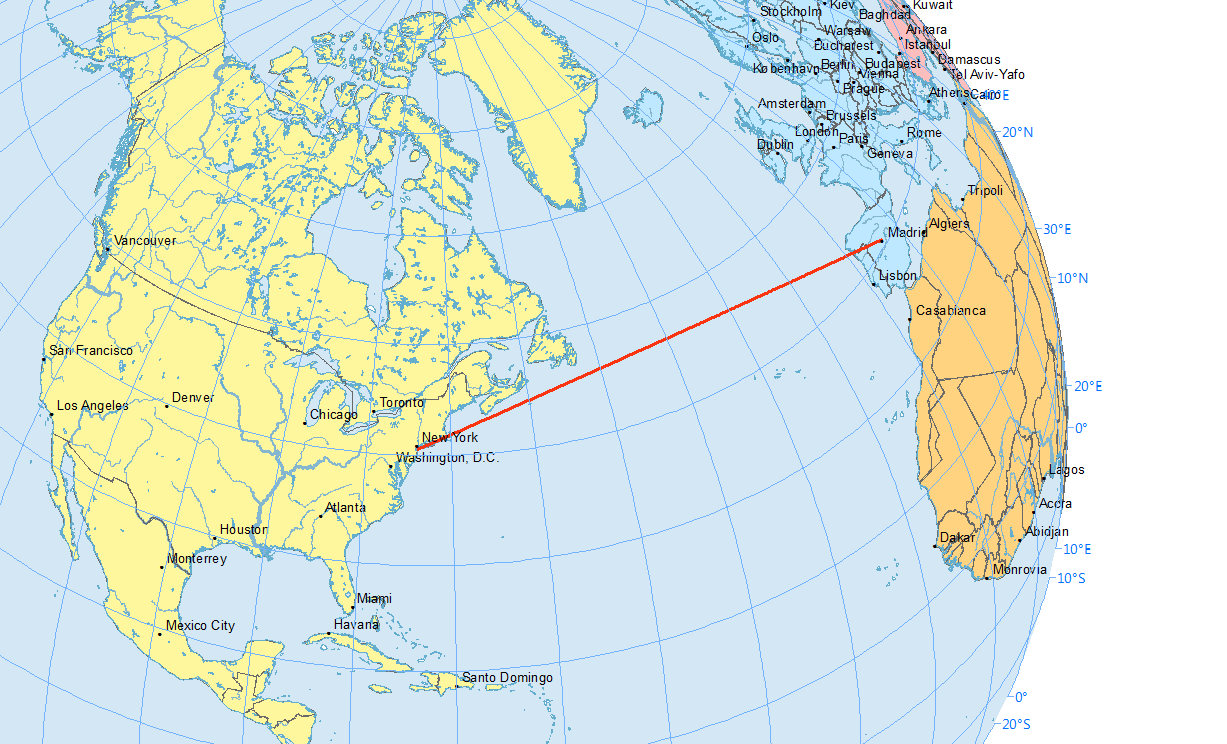
Why do you fly over Greenland in an airplane flight?
Or why is it that when you see flight paths on a map they always take a curved route between 2 cities?
It’s because planes travel along the shortest route in a 3-dimensional space.
This route is called a geodesic or great circle route . They are common in navigation, sailing, and aviation.
But geodesics can be confusing when you’re looking at a 2-dimensional map as they follow quite the odd flight path. Let’s dig into this concept a bit deeper.
Great Circle Routes Explained
In a flight path from New York to Madrid, if I asked you which line is shorter, you’d say the straight one, right?

However, a straight line in a 2-dimensional map is not the same as a straight line on a 3-dimensional globe .
This is why flight paths travel along an arc between an origin and a destination.
Now here’s what the same flight paths look like on a sphere. Remember that the straight line in the Mercator map above followed the 40° latitude line.

This paints quite a different story, doesn’t it? It’s deceiving to the human eye.
The takeaway is this:
A route that looks longer on the map is because of the distortion created by map projections like the Mercator Projection . In navigation, pilots often use great circles (geodesic) as the shortest distance flight.
Great circles vs small circles
Now that you have a visual understanding of great circles. Here’s a definition of what a great circle is:
- A great circle is a circle on the globe such that the plane passing through the sphere’s center is equal to the circumference of the Earth.
- Alternatively, a great circle is where the radius is equal to that of the globe representing the shortest distance between two points on the surface of the earth.
In basic terms, imagine you’re cutting into an orange. You can cut them at any angle – north-south, east-west, diagonally. As long as you cut two identical portions, then the circle where the cut was made is a great circle.
For example, the equator is a great circle because it’s the maximum possible circle:
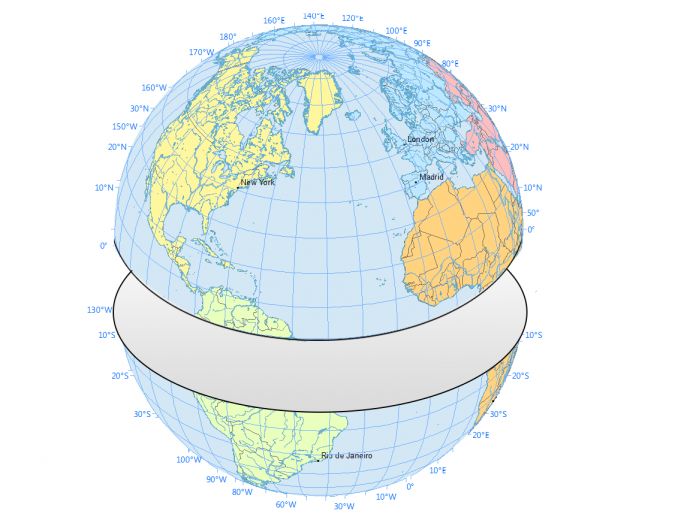
You could also cut it at the north and south poles. This longitudinal line also cuts two equal portions. Any meridian line is a great circle as well.

From New York to Madrid, here’s how the plane creates two equal segments.
A great circle generates two arcs with the shorter one being the shortest path. Here is the shortest path and how the plane is angled to create the shortest path.
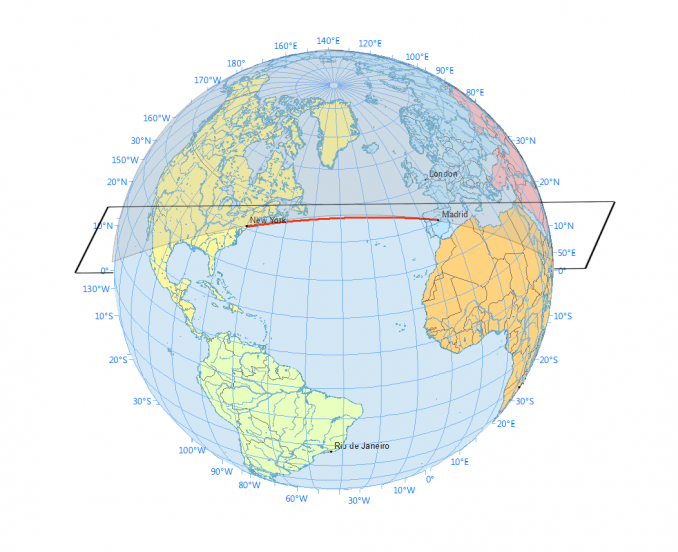
How about when you follow along the 40° latitude line? Anywhere that it doesn’t cut two equal pieces is a small circle .
While a rhumb line track is at a constant azimuth, a geodesic line changes direction all the time.

This fundamental difference in navigation concepts can have a significant impact on long-distance sea voyages.
READ MORE : Rhumb Lines: Setting it Straight with Loxodromes
How Geodesics Work
Planes travel along the shortest route in 3-dimensional space. This route is called a geodesic or great circle .
While map projections distort these routes confusing passengers, the great circle path is the shortest path between two far locations.
This is why pilots fly polar routes saving time and distance . And this is why pilots often fly over Greenland.
Have any questions? Please let us know in the comments section below.

25 Map Types for Building Unbeatable Maps

Epic Web Maps – The Maps Hall of Fame

50 Map Projections Types: A Visual Guide

How Map Projections Work

Esri JavaScript API Examples: 15 High-Tech Webmaps and Webscenes

Ocean Currents Map: Visualize Our Oceans Movement
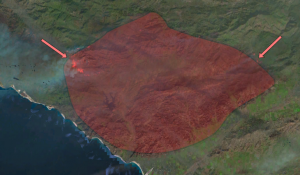
3 Wildfire Maps for Tracking Real-Time Forest Fires
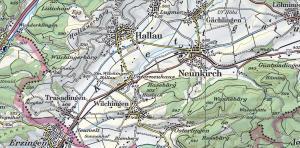
10 Topographic Maps From Around the World
38 comments.
Please, I want to use your draws in a aerodynamic book for engineering students (in spanish language).
Please, can you report me if I can use it?. In case of yes, wich will be the conditions?
kind regards !!!
Hi Victor. In this case, you can use these images. We are the creators of these graphics. Check out our guide how to cite – https://gisgeography.com/how-to-cite/
Way to conflate 2 different idioms: “This paints quite a different story, doesn’t it?” I think one paints a different picture or tells a different story. How does one paint a story, or tell a picture? Otherwise, a great article.
Buy a globe and figure it out.
I’m trying to figure out what flight path an LTA aircraft (Larger than Goodyear Blimp) would take from England to Idaho. It’s part of a novel I’m writing. Any suggestions?
You’re definitely on the right path and to use a great circle.
I am a layman. Please describe the route from Mumbai to New York and San Fransico to Tokyo through a diagram to show why airlines prefer polar routes?
A great circle connecting two points is the shortest distance but it requires frequent heading changes throughout the journey. A straight line (rhumb line) drawn on a Mercator projection map produces the constant compass bearing to follow for the same journey; which is easy to draw and much easier to follow. Over a short distance the difference between a great circle and a rhumb line route is negligible so the simple rhumb line route is used. However, over a very long journey the difference in distance will be quite significant so a great circle route is preferred.
In navigation latitude is the angle above (north) or below (south) of the equator. Longitude is the angle east or west of the prime meridian (ie the Greenwich Meridian). Both of these angular measurements are derived from the centre of the global earth mass. 0 degrees latitude, 0 degrees longitude is the intersection of the prime meridian and the equator (just south of Ghana West Africa).
When you try to draw a flat map to depict the surface of a globe there is a huge problem; imagine taking the peel off of an orange and trying to lay it out flat.
On the surface of global earth the horizontal distance measured between two meridians along the equator (0 degrees latitude) will be greater than the distance between the same two meridians measured along any other latitude because the circumference of each latitude gets smaller toward the poles so the meridians are closer together near the poles. However, the distance measured between two latitudes on the same longitude is the same distance on other longitudes because they will lie on a great circle.
For marine navigation the map solution generally accepted is the Mercator projection because of its unique property of representing any course of constant bearing as a straight segment that can easily be drawn on a flat map. Such a course, known as a rhumb line, is preferred in marine navigation because it is easier for a ship to sail in a constant compass direction to reach its destination even though it will be a bit further than a great circle route. For short distances the difference between the rhumb line and great circle route is negligible. For aviation the distance is more critical since it directly affects time, fuel and load. A simple solution is, where possible, create a sequence of short rhumb lines along the corresponding great circle route. In the modern era all of these positioning problems have been overcome by GPS satellite navigation.
These days we all take degrees latitude and degrees longitude for granted because they have been successfully used for over 2,000 years. Around that time there were early attempts to measure the circumference of the global earth. Early mariners setting off on long voyages either came ‘back’ or never returned; which for millenniums gave rise to the flat earth notion. The first circumnavigation of the earth was accomplished by the Magellan fleet sailing westward 500 years ago. I’ve personally used latitude and longitude to circumnavigate the earth 5 times.
I’ll finish with a reminder that latitude and longitude are both angular measurements derived from the centre of the global earth mass. If the earth were flat then for positioning on it there would be only one angle from the centre and a linear distance measurement from it… an idea that has never ever been tried and proven.
Taking all of the info from this page into consideration, how could it be used to strengthen flat earth theory? I was directed here because I wanted to learn what constitutes a “great circle” and I now understand. I seriously want to know how anyone could reach that conclusion.
High-altitude flying brings another problem to the fore. It is called “coffin corner” where if you fly slower you will stall, and if you fly faster you will also stall.
It actually makes sense if you go back to the comparison of cutting an orange. Again understanding how to navigate along a 3-dimensional globe while looking at a 2-dimensional picture is why it seems so confusing. And No Cari it doesn’t support the flat earth theory. Not even its own theory supports it. lol. The entire point of this is because of it’s a globe. If it were flat none of this would be necessary. Not to mention the Japanese would still be en route to Pearl Harbor if it were a flat earth. That’s an exaggeration but still, it would have been quite a long flight. One that those little planes would never have been capable of making. In fact, if the earth were flat many lives at Pearl Harbour as well as at both Hiroshima and Nagasaki would have been spared. It’s a shame that the earth is in fact round.
You have supported the theory of a flat earth. Thanks.
My wife just left Dallas for Tokyo. I looked on the flight plan and it goes up through Montana and Canada and over the edge of Alaska. I don’t see how this could be the shortest route to Tokyo from Dallas. It seems more like they are trying to avoid flying directly over the vastness of the Pacific Ocean in case there is a mechanical problem.
Having read all the above I’ve decided to go by boat.
Odd! I was told that because of centrifugal force, the Earth was compressed at the poles, thus making it wider at the equator. The great arc is a navigational compensation!
Meanwhile, the Egyptians, who started all this, still could not figure out the height of the pyramids even though they had Pythagoras. Not to mention that even today there is no certain way to measure the partial volume of a cylinder.
The Earth is flat and south polar centered. That’s it.
What about the direction of the route? Nobody can convince me that Madrid lies to the north of Newyork as they are saying now.
Maybe thats how they conclude it but its wrong, even if it works. the real reason is because of difference of rotational velocity of a shorter vs longer circumference. if you draw two lines from the center of a circle, each come out of the destinations. then draw two lines, one at altitude and the other at ground level. clearly the one at altitude is longer. it doesn’t matter if these lines are curved or not. what matters is the velocity the earth rotates at. the length of a circumference increases by 2 pi r. this means that at greater radius per starting location, the rotational velocity of a shorter radius vs a larger are varied. at a great altitude, though you are traveling at a perceived pace relative to the motor function, but you are multiplying that velocity by the increase in circumference relative to the ground’s. or vice versa, you can say the ground it traveling quicker as well since two point in the circumference have less distance to travel compared to the greater altitude. but what this really does is multiply the distance you travel at altitude relative to the ground. so one minute of flight at ground level vs one minute of flight at altitude results in greater distance. but its only if you fly against earth’s rotation. the earth is rotating at a constant speed, but the circumference between the greater height points travels at length over time just as the shorter one. but the shorter circumference then has less length to travel in that time, so its technically traveling slower. so as you increase height from the center of a circle, the increase in circumference, with earth’s rotation increase your velocity. if earth wasn’t rotating, then height wouldn’t matter and straight line would. 3 dimensions or 2… sure, you could look at it that way, but its over complicated…
Because the time it takes to fly to the higher altitude is not commensurate to the time lost by not climbing.
Let P = pressure, d = density, R = gas constant, T = temperature, h = height, g = gravitational acceleration.
By Ideal Gas Law PV = nRT -> d = n/V = P/RT
By the law of hydrostatic pressure
dP/dh = -d*g = P*g/RT
We know have a first-order separable differential equation. Solving this, we get:
Integral dP/P = Integral -g/RT dh log(P) – log(P0) = -g*h/RT -> P = P0*exp(-g*h/RT) d = P/RT = P0/RT*exp(-g*h/RT)
Therefore, as you go higher, the weight of the air column decreases reducing atmospheric pressure and density. However, the air also gets colder slightly increasing density. In the Stratosphere, temperatures increase with altitude instead of decrease. However, this layer of the atmosphere is above the troposphere where we live, so it has to be less dense. Thus, the weight of the hydrostatic pressure of the air column has a larger effect on atmospheric pressure and air density at least less than 10 km above sea level.
In the real world of long distance air navigation, great circle routes are *not* the shortest *flight* path, but they do make a good start on figuring out what will be the shortest flight path. The article fails to understand that aeroplanes travel in the air, which is moving, rather than fixed in relation to the earth. The origin and destination are fixed to the earth, if the sea and the air were likewise fixed, a great circle would yield the shortest path. A longer path with regard to the earth can yield flight path savings in the order of 30% to 50%, the classic example being North Atlantic flights in the forties, where savings of this order resulted from using Bellamy drift derived constant heading paths instead of great circle routing.
Aircraft need to travel the shortest route in the air, not in three dimensional space. Sometimes that will be the same thing, but not very often. For an air routing, you could use the barometric pressure at origin and destination plus the latitudes. Using these, you can calculate the drift for the entire flight due to pressure differences and Coriolis effect, the net geostophic winds. However, there may be jetstreams at less optimum altitudes that could provide considerable net improvement, even if more fuel is used per air mile (meaning movement through the body of air, not the 3D relationship with the earth), but lets not go there. Having derived a constant heading, it is flown, and neglecting political geography, with no concern for the position with respect to the position on earth below, other than the destination and not bumping into things.
To help with the lay understanding, imagine a rectangular table top, with a dot at each end. Over the top you have a much larger piece of perspex. You have a toy car which can travel at a speed equal to the distance between the dots over one hour. Over the course of an hour, the perspex moves half that distance to the left of the direct track, then half that distance to the right. If we attempt to stay on the “shortest” path from A to B, at the end of an hour, we will still be at A. If we calculate the net drift between A and B, which in this example means following a constant heading equal to the direct heading at the start of the journey, our path will be much longer than the direct path, a loop heading out to the left. However, after an hour, we will be at B. If we change the total distance moved by the perspex to half A-B, purely left and right, it will still take us one hour on the constant heading, but if we follow the direct path on the table top, we will get there, having taken considerably more than an hour to do so.
On shorter journeys in the real world, there are few wind reversals – there is also little difference between a rhumb line course and a great circle, so you may as well fly a rhumb line. Longer journeys are where this counts, and also where the great circle should be of use, but often is not, due to winds aloft.
The correct term is “Density altitude” which is a calculation of pressure altitude corrected for nonstandard temperature. As temperature and altitude increase, air density decreases. All aircraft have a flight “ceiling”, an altitude above which it cannot fly. As an airplane ascends, a point is eventually reached where there just isn’t enough air mass to generate enough lift to overcome the airplane’s weight. This is why (depending on the airplane) you might not be able to take-off from a high altitude airport on a particularly hot day. I have experienced this (pilot) myself several times.
If you depart from the North Pole with a plane along a meridian, directly from the rotation point (rotation axis) where speed is 0, to a destination at the equator where the rotation speed is around 1660 km / h , would the plane still reach its destination? From North Pole direct to Brazil(circular arc over meridian 60 W).
Thinner air does not give better engine performance. The reason flying high is more economical compared to flying at low altitude is because the TAS is higher due to density. Thus the amount of fuel burned per nm travel is lower.
You have such great figures. May I use one of them in a presentation to illustrate great circle routes?
Yes, you can. But please give credit by referencing to gisgeography.com
Chris, you are wrong. For air, D=PM/(RT), where D=mass density, P=pressure, M=molecular weight average, R=ideal gas constant, & T=absolute temperature. This is why you need to fill your tires with air in the winter. The temperature drop compresses the air, which means you have to add air to fill in the same amount of relative space.
There are many other atmospheric factors in play such as humidity, wind speed, and wind direction to consider as well.
…and yes, thinner colder air is better for fuel efficiency, but bad for lift. The higher you go, the harder it is to maintain altitude, so like everything else, there is a trade-off. Airplanes are designed to take advatange of the thickness of the air at a certain altitude. That altitude is not fixed relative to the ground, but depends on the weather. So on a hot day, they can fly higher. On a cold day, they.have to fly lower. But there is always an optimum “temperature altitude” for any given plane on any given day. You can’t just keep going up forever. You need pressure under the wings, or you’re flying a brick.
Airplanes need air pressure to fly, it doesn’t matter how dense the air is if there’s no pressure, and pressure and altitude have a consistent relationship. Does that make sense?
Actually, you’re all right, but you’ve each only got two-thirds of the puzzle. There is no direct relationship between temperature and density. There IS a relationship between PRESSURE and temperature and density.
In aviation, there is a concept called “termperature altitude.” So the actual relationship is between all three of them, but the focus is only on the two. The higher you go, the colder and thinner the air gets because the pressure is dropping. For every 1000 feet you go up, there is an expected drop in temperature and pressure, and this remains constant. So flying through colder air is like flying higher. The colder air makes the pressure go down while the density remains the same. The airplane acts as if the air is less dense. Got it?
I too, like Mr. Bir, noticed that there was something wrong with the explanation regarding the density of air. Yes, as air gets colder it gets denser, that’s why to start a cold gasoline engine you have to activate the ‘choke’ which in turn will supply the fuel-air mixture with an extra amount of fuel in order to compensate the leanness that otherwise would not start a combustion.
J Bir, unlike liquids the viscosity of gases inceases with increasing temperature. This can be explained using the kinetic theory of gases.
Mr Bir has it right on, as soon as I read it, I questioned it. But we appreciate your explanation of the great circle route. Good article.
Let me correct you. As the air gets colder, it gets denser, not thinner. However, as you increase in altitude, the air gets thinner and colder. Pilots will always want to fly higher as the low density of the air reduces drag and thus increases the efficiency of the fuel.
Every airline in the world has a business route. This route determines where the aircraft can and cannot fly. For example certain routes over the Atlantic are more costly to make but much faster, the final determination is down to the pilot, in regards to how much fuel he has on board, how delayed the aircraft is, in respect to flying faster than he normally would. This is a very significant thing when determining which transatlantic route to take, because there are at least a dozen of which only 3 of those routes are the fastest and most economical, the rest vary with flight cost. In respect to flying over Greenland, there was a very valid reason to do so especially during the winter and early spring months. As the air gets colder, it gets thinner, and the air thins it gets more and more difficult for an aircraft to stay in the sky. This meant under aviation rules, those aircraft with only 2 Jet Engines had to make the shortest distance between land masses, incase an engine stopped working. This way the pilot could make an emergency landing. Aircraft such as the 747 had no such problems, and could easily fly the quickest transatlantic routes. However over the decades Jet Engines have become increasingly reliable, so much so, that they too can now fly over the Arctic to whatever destination. There are very few airlines who actually use Arctic routes, because these routes are extremely expensive to use. An example of a flight from Helsinki (EHFK; HEL) to Barcelona (LEBL, BCN) does not use a Great Circle nor a Small circle, it uses a direct path from point A to B.
Small circles are not always used for short distances, infact they are seldom used in Europe. Instead most short distances are literally from A->B.
Why are small circles used in short distance trips and not the latter?
Leave a Reply Cancel reply
Your email address will not be published. Required fields are marked *

COMMENTS
Circle is proud to announce the launch of the Travel Rule Universal Solution Technology (TRUST), an industry-driven solution designed to comply with a requirement known as the Travel Rule while protecting the security and privacy of our customers. TRUST is a platform that allows cryptocurrency exchanges to securely send information legally ...
Travel Rule On-Chain. Avoid errors when performing $3000+ transfers by complying with the FinCEN Travel Rule. Due to FinCEN guidance regarding transfers of $3,000 or more, Circle APIs may require you to share information about the originator of the transaction to prevent the transfer from failing. According to FinCEN guidance regarding ...
The "Travel Rule" refers to the U.S. Bank Secrecy Act rule as well as guidance defined by the international Financial Action Task Force (FATF) Recommendation 16.The Travel Rule requires Financial Institutions (FIs) and what FATF refers to as Virtual Asset Service Providers (VASPs) to exchange and analyze specific PII data about the originator and beneficiary of a given transaction when such a ...
Circle is pleased to announce the international expansion of the Travel Rule Universal Solution Technology (TRUST), a global, industry-driven solution designed to comply with a requirement known as the Travel Rule while protecting the security and privacy of customers. In February of this year, TRUST launched in the United States.
Bringing compliance to crypto. TRUST is a global, secure, and industry-driven solution designed to comply with a requirement known as the Travel Rule while protecting the security and privacy of our customers. TRUST was designed and built collaboratively by leading crypto exchanges to set the standard for Travel Rule compliance.
To help meet this new challenge of creating interoperable systems for compliance, Paxos, with partner members including Coinbase, Circle, Gemini and Kraken, introduced Travel Rule Universal ...
Crypto firms including Coinbase, BlockFi, Gemini, Kraken, Robinhood, Circle, and Fidelity Digital Asset Services announced the launch of the Travel Rule Universal Solution Technology, or TRUST.
For instance, the threshold at which the crypto travel rule kicks in the U.S. is $3,000 (i.e., the rules come into play when the value of the crypto transaction exceeds $3,000).
The Bitcoin travel rule, officially known as the FATF (Financial Action Task Force) Recommendation 16, is a regulatory requirement claiming its aim is to combat money laundering and terrorist financing by enhancing transparency in cryptocurrency transactions. This rule, adopted by the FATF in 2019, mandates that virtual asset service providers ...
The Travel Rule may prompt a yet unanticipated "squaring of the circle," maintaining privacy while enhancing identity data collection and circulation. A new international rule requiring ...
18 VASPs Launch TRUST in Order to Comply With FATF's Travel Rule. For quite some time now, FATF's Travel Rule has been a top concern within the crypto industry as virtual asset service ...
PARIS - July 1, 2024 - Circle, a global financial technology firm and the issuer of USDC and EURC, has today announced that it has become the first global stablecoin issuer to achieve compliance with the European Union's landmark Markets in Crypto-Assets (MiCA) regulatory framework. This achievement was enabled by the company's attainment ...
Circle Fares Restrictions and rules on circle itineraries vary by airline, but usually take one of the two following forms, both a variation on the old "Saturday night stay" rules: 1.
Select the left lane, adhering to road markings. Activate the left turn signal before entering. Circulate in the left lane, passing the first and second exits. Nearing the third exit (from your initial entry point), activate the right turn signal. Leave the roundabout on the third exit and deactivate the turn signal.
This one simple strategy for packing light, the 10-$10 rule, can make saving space in your luggage easy. You might avoid the risks and costs of checking a bag.
FIN-2010-G004. The following is revised guidance to financial institutions on the transmittal of funds "Travel" rule. This guidance updates the document "Funds 'Travel' Regulations: Questions & Answers" issued in 1997. It includes a parenthetical at the end of each answer indicating the date the answer was issued.
Travel Tips: 3-1-1 liquids rule. You are allowed to bring a quart-sized bag of liquids, aerosols, gels, creams and pastes through the checkpoint. These are limited to 3.4 ounces (100 milliliters) or less per item. This is also known as the 3-1-1 liquids rule. Select Filter
The Travel Rule was promoted by FinCEN, in keeping with their mandate to enforce the Bank Secrecy Act. "Recordkeeping Rule". Requires financial institutions to collect and retain certain information related to funds transfers and transmittals in amounts of $3,000 or more. 31 CFR 1020.410 (a) and 1010.410 (e) "Travel Rule".
Liquids Rule. You are allowed to bring a quart-sized bag of liquids, aerosols, gels, creams and pastes in your carry-on bag and through the checkpoint. These are limited to travel-sized containers that are 3.4 ounces (100 milliliters) or less per item. Placing these items in the small bag and separating from your carry-on baggage facilitates ...
Here's the equally valuable 1-3-1 rule, a handy cheat code to help you deal with a flight delay: one app to keep you in the loop, three methods to connect to the offending airline and one ...
Planes travel along the shortest route in 3-dimensional space. This route is called a geodesic or great circle. While map projections distort these routes confusing passengers, the great circle path is the shortest path between two far locations. This is why pilots fly polar routes saving time and distance. And this is why pilots often fly over ...
Rule one - pets need to stay inside the travel container. In the US, where pets on planes are a common sight, not everyone is happy about it. Many times, I've seen owners take pets out of ...
Curtis L-M Rule, Frequency Response Calculator 1953 ISRM 14.04.30.01. The above circular slide rule belonged to Ben Emmerich (1922-2010). He was a German aircraft engineer who in the course of his career helped develop the Transall, the Starfighter, the Tornado and the Eurofighter. The slide rule was donated in his memory by his family.
A great circle is a circle on earth where the center is in the center of the earth. That is always the shortest path on the surface. If you have a physical globe and you take a string and stretch it between two-point the path of the sting will be the shortest distance and a great circle path.
We therefore looked closely at rules for similar challenges for the London Underground and for the New York Subway, and applied them exactly (where possible) to our Moscow Metro Challenge (rules 1-5). We have also included the rules that Guinness insists on for the time to be accepted as an official rapid transit challenge world record (rules 6 ...